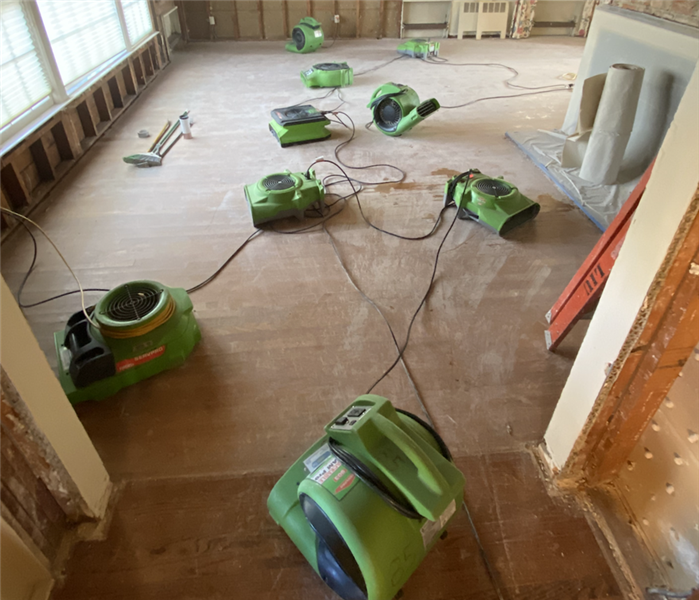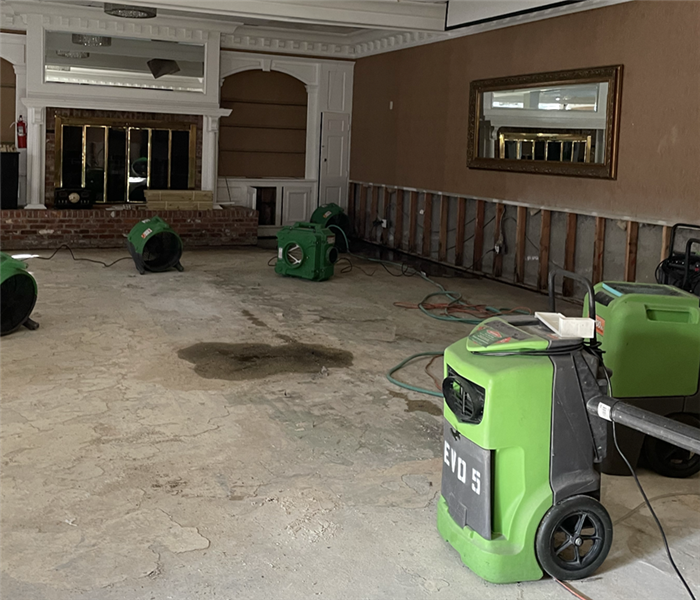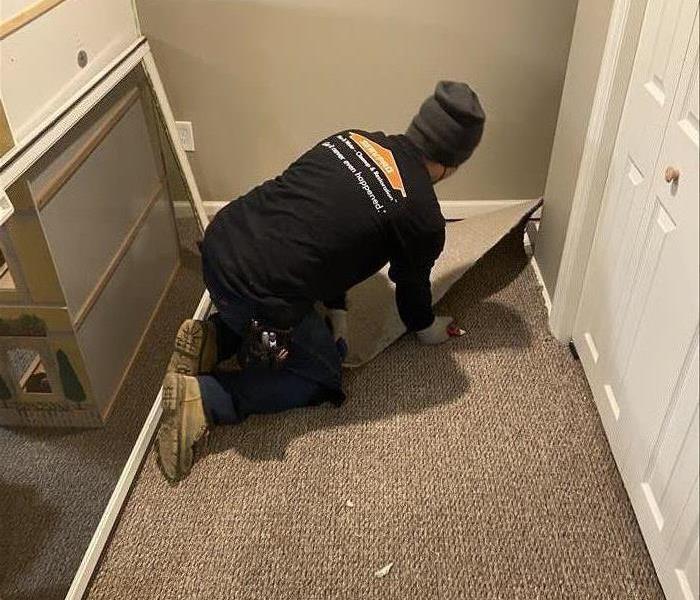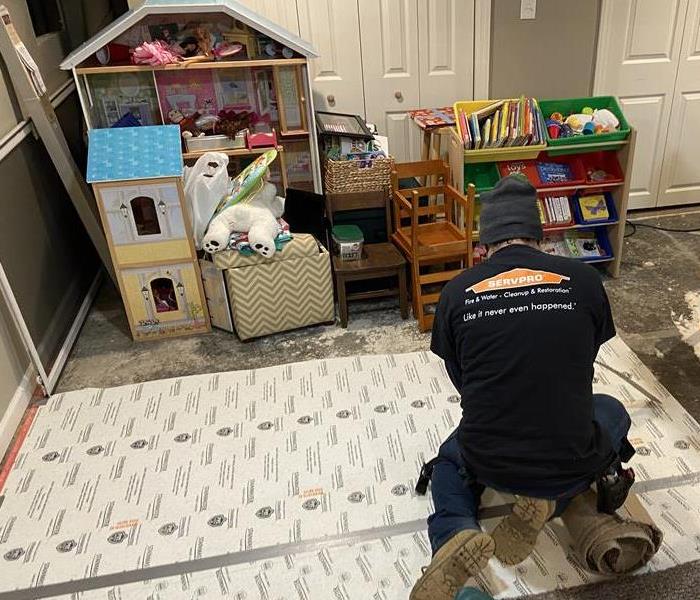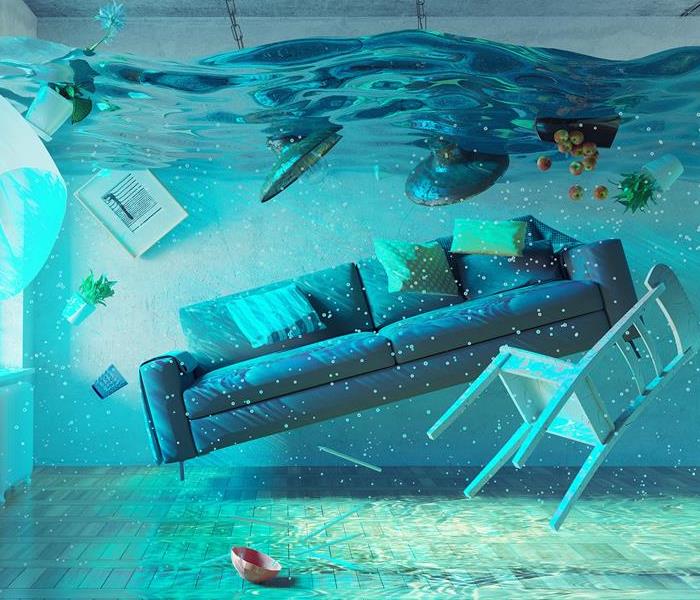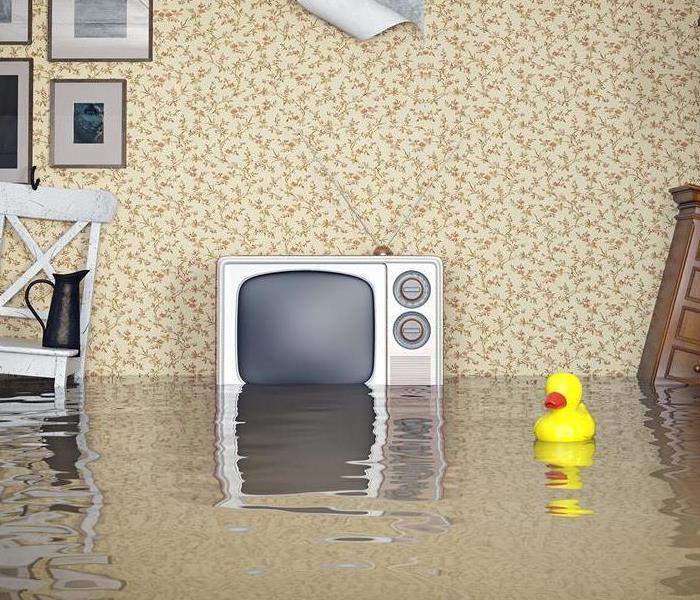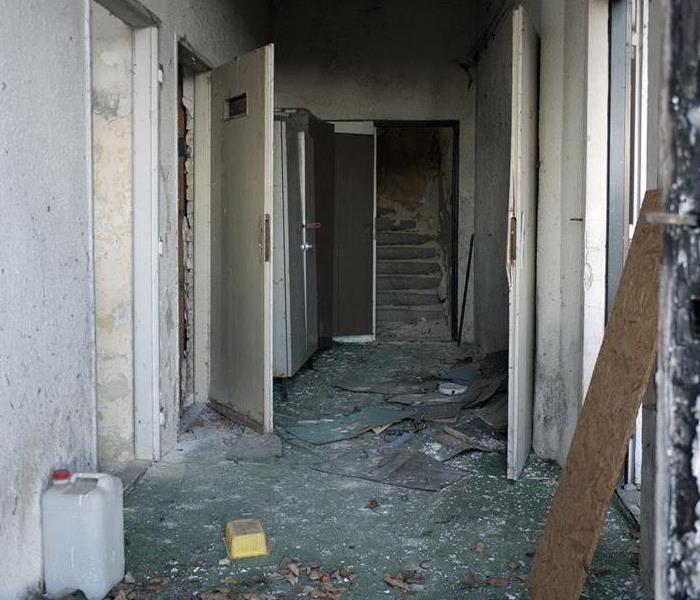Recent Water Damage Posts
Common Causes of Water Damage in Manhattan Properties
7/16/2023 (Permalink)
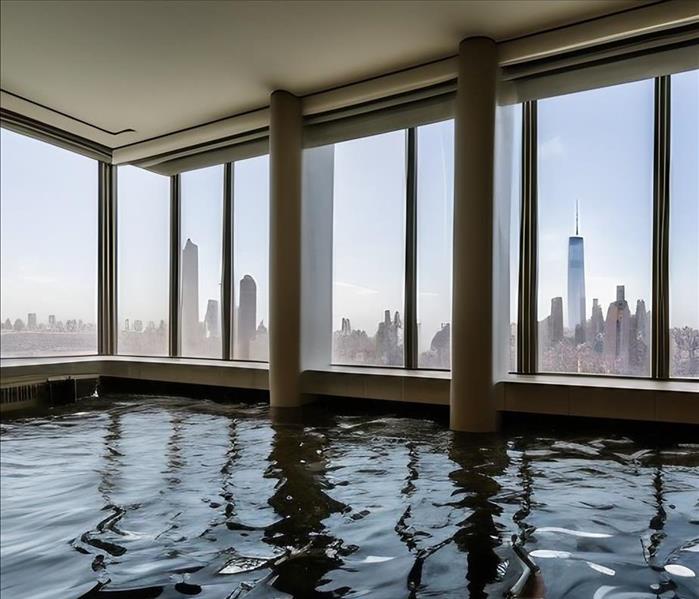 Water knows no boundaries - even in the heart of NYC. Don't let unexpected floods dampen your spirits, let SERVPRO Manhattan restore your home and pea
Water knows no boundaries - even in the heart of NYC. Don't let unexpected floods dampen your spirits, let SERVPRO Manhattan restore your home and pea
Water damage can lead to devastating consequences, from structural issues in your home to potential health hazards. For residents in Manhattan, it's essential to understand the common causes of water damage in order to prevent these issues from arising. Here are some of the most common sources of water damage in Manhattan properties:
1. Plumbing Issues:
Often hidden behind the walls, plumbing problems are one of the most common causes of water damage. Whether it's a slow leak from a loose fitting or a burst pipe, water can accumulate over time and cause serious harm to your property. Regular inspections and maintenance of your plumbing system can prevent these issues.
2. Faulty Appliances:
Home appliances like washing machines, dishwashers, and water heaters can cause significant water damage when they fail. These appliances have a finite lifespan, and as they age, their pipes can rust and hoses can weaken, leading to leaks or floods.
3. Roof and Window Leaks:
The harsh New York winters can take a toll on Manhattan roofs, leading to leaks and water damage. Windows, too, if not well-sealed, can let in rain and melting snow, causing damage over time. It's vital to regularly check these areas and address any necessary repairs promptly.
4. Basement Seepage:
Manhattan's high water table and frequent rainstorms can cause water to seep into basements. This problem can be further exacerbated by cracks in the foundation. Waterproofing your basement and repairing any cracks can help prevent this form of water damage.
5. Natural Disasters:
Manhattan is susceptible to natural disasters like hurricanes, heavy rains, and snowstorms, all of which can lead to severe water damage. While these events are often unavoidable, having a plan in place and responding quickly can mitigate the damage.
6. HVAC System Issues:
HVAC units, especially when not regularly serviced, can cause moisture buildup and subsequent water damage. A malfunctioning AC unit can cause condensation to accumulate and overflow the drip pan, damaging surrounding areas.
Recognizing and mitigating these common causes of water damage can help keep your Manhattan property safe and in good repair. However, should you experience water damage, it's crucial to act quickly. A professional water damage restoration service like SERVPRO of Midtown Manhattan can ensure the water damage is dealt with effectively and efficiently, preventing further damage and potential mold growth.
Remember, preventative maintenance is your best line of defense against water damage. Stay vigilant, perform regular inspections, and when in doubt, call the professionals. Team Holmes is available 24/7 call us today at 212-768-9400.
Kitchen Disasters
7/16/2022 (Permalink)
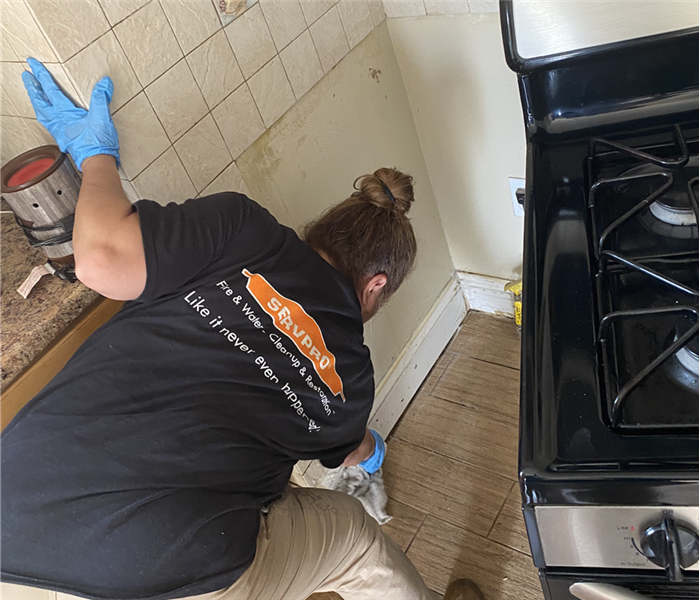 Cleaning up behind appliances is crucial!
Cleaning up behind appliances is crucial!
What Happened?
The common cause for these water leaks is the plastic water line behind the refrigerator will crack, a slow drip begins and water pools behind the fridge unnoticed. Another common cause is excess condensation buildup which has the same effect. Water damage from your fridge can cause numerous problems in your home especially since the problem can go unnoticed for so long, at this point the damage has already taken a toll on your floors and surrounding areas. Moisture and heat in the dark environment create perfect conditions for mold to form and your floorboards to rot. Somewhere like an apartment or enclosed area these mold spores can cause issues and a problem like this should not be overlooked. Over at SERVPRO we are experts in mold remediation and will gladly remove and prevent further frustrations for you.
Now What?
It is important to first clean up any visible water to avoid further damage and possibilities of mold occurring. Once this is done you should inspect your fridge and see if there are any noticeable leaks or areas where condensation may be forming to excess. It is important to replace any faulty connections to stop the immediate leak if possible. If you are able to, assess the damage done to the area under and around the fridge. Most of the time floorboards will show visible damage, but the real problems can occur underneath where you cannot see. We recommend you give us a call at SERVPRO of Midtown Manhattan (212-768-9400) where we are available 24/7 to assist. We will send a team out to stop any further damage and spread of mold and help prevent this issue from occurring again. While you may be able to swap out the damaged areas of flooring, mold can continue to grow and cause more problems in the future. With many years of experience we will make the cleanup a quick and easy experience.
Pro tip: add a water alarm behind/under your fridge to catch any further problems from getting far
Where Does the Water Go?
2/22/2022 (Permalink)
So Where Does the Water Go?
It's a frustrating scenario trying to figure out where the water ends up after a leak occurs. When a leak is discovered from an appliance or an open entryway (window, door, hole), it's crucial to find out proper steps to take.
In the case of multiple-units, like co-ops or apartment buildings, it's even more difficult to deal with. It is necessary to find the travel of water to determine a water restoration solution properly. Multi-unit housing is not an unexpected location for such detective work, as every apartment is typically plumbed separately, yet shares walls, ceilings, and floors with other living spaces. It is inadequate for a landlord to respond only to the complaint of one tenant when it is very likely that the water from the leak eventually spreads throughout the building where you cannot even see it and other tenants have not yet noticed.
Is It Easy to Follow the Spread of Water from Space to Space?
Water is often characterized as moving along the path of least resistance. This fact does not always hold up to scrutiny, as a number of other factors weigh in. For example, if water runs along the outside of a pipe, think condensation on a cold water supply pipe parallel to the floor in a warm, damp basement, some water will drip in a line along the expanse of the pipe to the floor. Instead of just one wet spot below the pipe, there will be many damp areas, tracing on the floor over the length of the pipe. If, on the other hand, the cold pipe is perpendicular to the floor, the condensation will tend to run down that pipe, depositing in a circle around the bottom. Other examples can result in even more varied answers.
So How Do Trained Technicians Follow the Water?
Since water follows pathways not quite as straightforward as folklore might think, SERVPRO must find more reliable ways to discover where water migrates and hides. Our technicians master basic moisture detection strategies during the Institute of Inspection, Cleaning, and Restoration Certification (IICRC) training. We use detectors with and without prongs to locate the presence of moisture, helping us trace the outline of a water incursion. For added data, we also employ special moisture meters to determine levels of water absorbed by permeable materials. The moisture levels become baselines for our Applied Structural Drying (ASD) technicians when we move on to determining drying goals after we remove all standing water.
Why Does It Matter? Shouldn’t the Water Just Dry Up Inside the Building?
One of the concerning factors to consider is the possibility of mold growth if all water is not removed from every space within an apartment building. Mold spores need only a small amount of moisture to “germinate” and begin their growth curve. Only oxygen, water, and an organic surface upon which to multiply are necessities for molds. No light is required so that mold colonies can breed in between walls, above ceilings, and in any building cavity. Because of the potential of mold damage when wood framing, drywall, ceiling tiles, and other building materials are just slightly wet, landlords must find and make arrangements to remove all water after a leak.
How Do Professionals Get Water Out of Confined Spaces?
Portable extractors can be brought far inside the units of even a large apartment building. The mobile units are much more flexible in uses, fitting in tight spaces much easier than the large yet more powerful truck-mounted variety. The equipment can be carried like a backpack, capable of extracting up to 12 gallons of water before needing to be drained to begin a fresh attempt to remove all the water practical. If the extractor cannot reach moisture, even with extenders, we have to consider some controlled removal techniques such as drilling access holes into the drywall.
We Target the Source of Water Damage
2/9/2022 (Permalink)
We Target the Source of Water Damage
There are a lot of reasons why water damages happen, oftentimes it can come "out of nowhere". Addressing these concerns begins by identifying the source of the damage, which can sometimes hide behind layers of wall or ceiling materials. In some situations, you might not be sure that a water loss exists until you can recognize some of the effects these incidents can leave behind.
When you suspect water damage to your office building, you want to resolve it as soon as possible. Prolonged exposure to moisture creates more damages to the structural elements as it allows for more compromising effects like deterioration or mold growth. Our SERVPRO technicians have a fast and thorough response that can help you to not only identify water losses and moisture, but dry up this damage to make it “Like it never even happened.”
How Do You Identify Water Damage?
When you are not sure that a water loss incident exists, how can you know for sure? Several indications that can reveal water or moisture, even if the majority of this damaged area exists behind surface materials in wall cavities or structural openings. You can start by looking for things such as:
- Yellowing – Drywall is one of the most common structural materials used in office spaces. While you do not typically have to worry about the metal framework becoming damaged by water, drywall can quickly and readily absorb moisture and water from a persistent leak. The surface around this water-damaged area of the sheetrock can often show yellowing in an uneven blotch.
- Spotting - Prolonged exposure to moisture, or the unresolved saturation of materials, can facilitate mold growth in areas that you cannot see. The migration of mold colonies can show as spotting on the surface of the drywall, which can be multiple colors: black, green, blue, or even orange.
- Material Deterioration – Sagging or damaged materials are often an excellent indication of water damage. As materials get saturated, they can become too heavy for screws or nails used to install them to support them. Sagging ceilings or bloated wall surfaces can indicate a substantial water loss concern.
Do You Need Professional Restoration for Damp Drywall?
With drywall being such a key and standardized element to most buildings, restoring it after a water loss is something that you want to address immediately. Because these materials can become irreparably damaged in often as little as 24 hours of exposure, removal and reconstruction is often the fastest and most reliable approach for overcoming damp drywall. Our SERVPRO professionals can help with restoring these damaged areas and elements in the office, as sheetrock can be a considerable challenge due to:
- Structural Deterioration – Exposure to migrating water or moisture in any area of your office can allow for the bloating and deterioration of drywall surfaces.
- Porous Surfaces – The sheetrock’s permeance and porosity make it one of the most susceptible structural elements to moving water or the presence of moisture in the environment.
- Facilitate Mold Growth – Because drywall is an organic material, it can be a host for developing mold colonies.
No matter how subtle water losses might initially appear, they all must get addressed with the same care in the cleaning and restoration process, as soon as possible. SERVPRO of Midtown Manhattan can help 24/7 each day of the year by calling (212) 768-9400.
Dirty Water Cleanups
1/17/2022 (Permalink)
Did You Know There Are 3 Varieties of Water Damage?
If the disaster seems manageable you may be tempted to handle it yourself, unlike a large flood or burst pipe. While this may seem like a cost saving idea in the short run, the hazards and future problems can become very costly. In reality, cleaning up and restoring a water damage isn’t always as straightforward as it seems.
Below we have highlighted three major things you need to be aware of when addressing water damage from a small to big water loss.
1) Know What You’re Dealing With
Water damage can be caused by the three types of water listed:
- Clean water (Category 1)
- Gray water (Category 2)
- Black water (Category 3)
It’s crucial to understand the differences between each of these categories, Category 2 and Category 3 water both present risks to you, your employees, customers and loved ones. And all three categories need to be handled in a different manner to be done properly.
Clean Water-
The most common sources of clean water normally come from a pipe, water heater, steam lines or even rainwater after a storm. The basic rule of thumb- it should look and smell like tap water. These types of water can be handled with normal water loss procedures, however recovering from Category 2 and Category 3 water damage involves additional considerations.
Gray Water-
A Category 2 water loss, or “grey water” refers to a source of water which contains a large degree of chemical, biological, or physical contaminants that can cause health effects.
Black Water-
Category 3 water loss involves water that is contaminated and can contain pathogenic, toxigenic, or other harmful agents. Such water contains things like silt, organic matter, pesticides, heavy metals, regulated materials, or unsafe substances.
2) Make Sure You Investigate All of the Damage
The challenging thing about recovering from water damage from something like a broken pipe or storm damage is that you can typically only see the visible surface damage. The majority of the moisture is actually hidden in walls, floors and more, making it necessary to identify and thoroughly dry all of the affected areas to prevent mold growth. If the wall has insulation, we will use flood cuts. We may even need to remove your base molding and flooring materials depending on damage, these are things that can become overlooked doing it yourself.
3) Establish Proper Airflow and Keep the Windows Closed When Drying
Once moisture becomes present, your first thought may be to open windows to assist in the drying process, in reality this may not be your best move. For example, if your building is mechanically ventilated, the systems need constant pressure levels to work correctly. You should avoid excess heat, cold, and humidity, or you may end up slowing the drying process. After we remove wet materials and create necessary cuts in the walls, we begin placing down drying equipment. This process continues until moisture meters read safe levels again.
No matter what type of water damage you’re dealing with, don’t hesitate to call us. SERVPRO of Midtown Manhattan is here to help!
Burst Pipes= Big Problems
1/16/2022 (Permalink)
As the weather gets colder, many residents experience frozen pipes as a side effect. While freezing temperatures are not year round, it's important to know what to expect when they do occur. If temperatures drop and you happen to encounter a leak in your house, it could be due to a variety of factors:
- An improperly connected appliance.
- Clogged Drain
- Broken sink, bathtub, toilet, washing machine, or dishwasher.
- A clog in a drain.
- Or a broken pipe
The very real possibility of a broken pipe. A broken pipe can cause an enormous amount of damage to your home. In particular, the most amount of damage occurs when you don't know where the break is or if you don't have direct access to the water break.
Broken pipes occur for a variety of reasons: freezing, corrosion, water pressure.
Freezing
With colder weather, extreme temperatures can cause pipes to expand and break. Once the ice melts, the water can flood your home. It's important to note that pipes can freeze when they are exposed to temperatures below 32 degrees Fahrenheit. In particular, the pipes that are most prone to freezing are found in unfinished basements and in attics during the colder months.
Corrosion
Older pipes break down with age, and require a trained professional in order to replace pipes. If ignored, it can cause an enormous amount of flooding. It's best to have a professional like SERVPRO of Midtown Manhattan to come inspect your pipes if they are older and may need replacing.
Water Pressure
High pressure can cause the pipes in your home to break. Water is transported from a water company supply line to the house, needing to pass through a pressure regulator. If the regulator is faulty, it can cause the water pressure to rise exponentially. If the pressure gets high enough it can lead to a pipe breaking in your home.
Why Us?-
SERVPRO of Midtown Manhattan is an expert in resolving water damage. If a pipe breaks, we are there to help you clean up the water and damage as well as properly dry out your home. Our Project Managers and technicians are able to help you locate the source of the water, to clean up the damage from where it started. We take extra care to ensure that there is no moisture left in your surfaces. If a broken pipe ever occurs on your property, make sure that you give us a call and we will be right there!
Leaving the Water Damage Up to the Pros
1/14/2022 (Permalink)
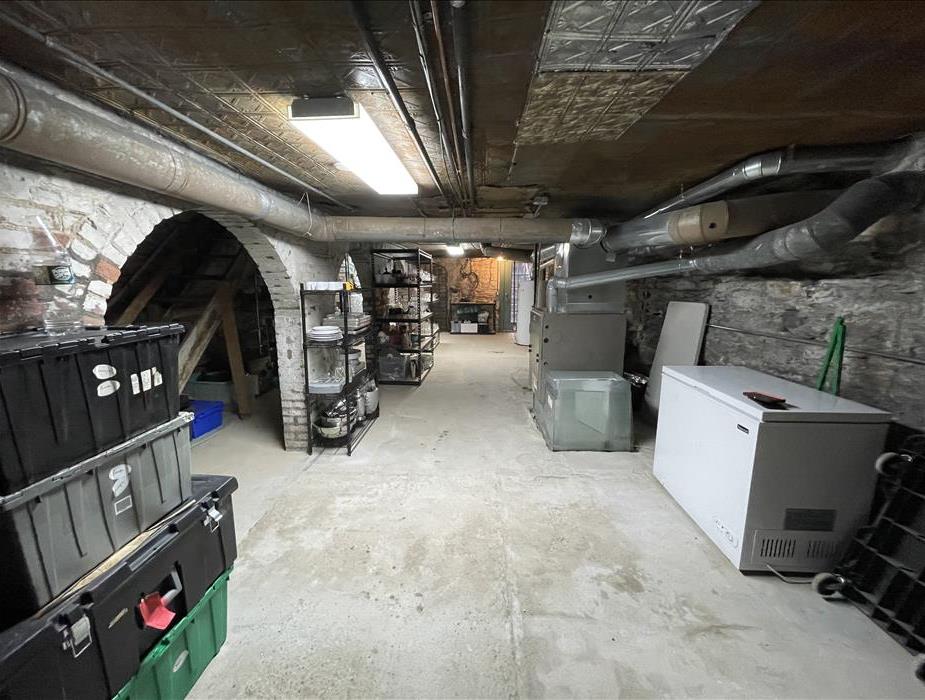 Your once flooded basement can look like this!
Your once flooded basement can look like this!
Your Contents During a Water Damage
There are 3 phases regarding the contents of your home/building SERVPRO of Midtown Manhattan will take to restore your property. Following these steps allow us to efficiently do our job, restore items that can be saved and reduce damage to the structure as quickly as possible.
Pack Out-
Our Content Specialist will begin the process by thoroughly inspecting inventory, then begin to physically package, move and ready the items to be stored, to ensure minimal damage is brought onto your property during the unforeseen loss you just encountered.
Content Cleaning-
Our expertly trained cleaning specialists are certified professionals who are knowledgeable about the various types of content and the appropriate cleaning procedures necessary, as well as the factors that cause/caused them.
Content Inventory-
During the damage analysis, home item inventory, pack-out and resetting stage of our services; our well trained Inventory Specialists will take photos of each and every step along the way, creating an inventory of what was salvageable and what was unsalvageable.
With a focus on limiting the damage, we always work as fast as possible to protect your property from further damage. During the entire process we work directly with your insurance agent or adjuster on your loss for a streamlined and expedited process. We always will keep in contact with you so you know what is going on while we work with your property.
A Recap of what SERVPRO of Midtown Manhattan can do for you-
- Professional and Concise Inventory of Contents
- Pack Out and Moving Services
- Specialized Cleaning and Decontamination of Contents
- Contents Repair and Restoration
- Secure Contents Storage
- Thorough and Accurate Pack-Back and Reset Services
Do you or someone you know need their property professionally inventoried, packed up and stored in a safe and secure facility? If so, don’t hesitate and give us a call today!
My Pipe Burst… Now What?
1/13/2022 (Permalink)
Flooding in your home from a burst pipe, what is next-
A burst pipe is one of the last things you want to come home to, the mess and damage it causes is not a simple cleanup. It definitely is going to be easier with some professional help…
Follow the steps below to control damages from a broken pipe:
- Immediately turn off your home’s water supply using the main cutoff valve.
- Drain your pipes by running cold water through the faucets and flushing the toilets.
- Thoroughly dry affected areas by running fans for approximately 2-5 days depending on the severity.
- If repairs and cleanup turn out to be more than you can handle, contact your insurance company. Most homeowner policies cover burst pipe water damage, and you should let your agent know you'd like to hire SERVPRO.
Don't wait to give us a call!
We have enjoyed a warm winter so far here in New York City, but it’s best to be ready for the unexpected cold we know very well. By knowing what to watch out for, what to do and who to call, you can minimize the problems from ruptured pipes on a cold winter day.
And remember, our team is always ready to help you clean up a water damage and complete the necessary repairs. We take care of it all, start to finish and we even offer our certified mold remediation services if necessary. When a broken pipe in your home tries to ruin your winter, give us a call here at SERVPRO of Midtown Manhattan and let us get your life back to normal as fast as possible.
What Can Affect Water Removal from Midtown Manhattan Homes?
1/25/2021 (Permalink)
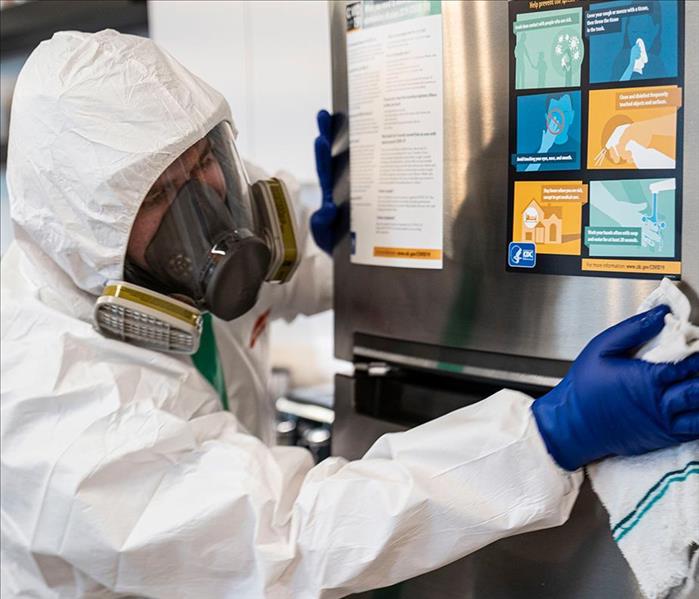 Dealing with water damage? Don't go it alone, our Midtown Manhattan team is here to help you with any size problem.
Dealing with water damage? Don't go it alone, our Midtown Manhattan team is here to help you with any size problem.
Our Team Has Highly Trained Technicians Who Can Troubleshoot Hard-to-Spot Water Damage Issues
No matter what type of water damage, the average person can have difficulty performing water restoration. Although each situation is unique in terms of determining the outcome, there can easily arise oversight of minor issues such as moisture movement can influence the experience negatively. When SERVPRO responds to an incident at your Midtown Manhattan home, one of our responsibilities is to ensure that the job is done correctly by skilled technicians who can identify and treat your home.
Why is moisture movement hard to detect?
Moisture movement can complicate water removal from your Manhattan home by necessitating sophisticated removal procedures or demolition to reach hidden areas. Such steps lead to higher costs or lengthen restoration periods.
The four main methods of moisture movement are:
- Liquid flow
- Capillary suction
- Air movement
- Vapor diffusion
Apart from liquid flow, which you can readily see, the other processes are hard to notice without the use of advanced techniques or tools. As the moisture moves, it transfers damage from the areas initially affected. It also causes further deterioration of materials.
What can stop moisture movement once water spills?
Although understanding that moisture movement is happening is useful, stopping the process is not that easy. Our SERVPRO technicians help by using several approaches, including:
- Expediting water extraction to limit the liquid flow
- Running dehumidifiers to manage humidity, limiting moisture spread through air movement
- Making flood cuts or removing wet materials to curb capillary suction
We have different types of water removal equipment, which ease removal under different circumstances. For instance, submersible pumps are perfect when the water pools deeper than 2 inches, while portable units help ease access to different sections of the property.
Taking these steps earlier helps minimize secondary damage caused by moisture migration. You can end up reducing costs involve or improve the turnaround time of the entire renovation task.
Water removal can run more smoothly with an experienced and well-equipped team at your side. Call SERVPRO of Midtown Manhattan at (212) 768-9400 to help. We're Faster To Any Size Disaster.
Why Can't I Remove Water Myself In My Manhattan Home After A Flood?
1/19/2021 (Permalink)
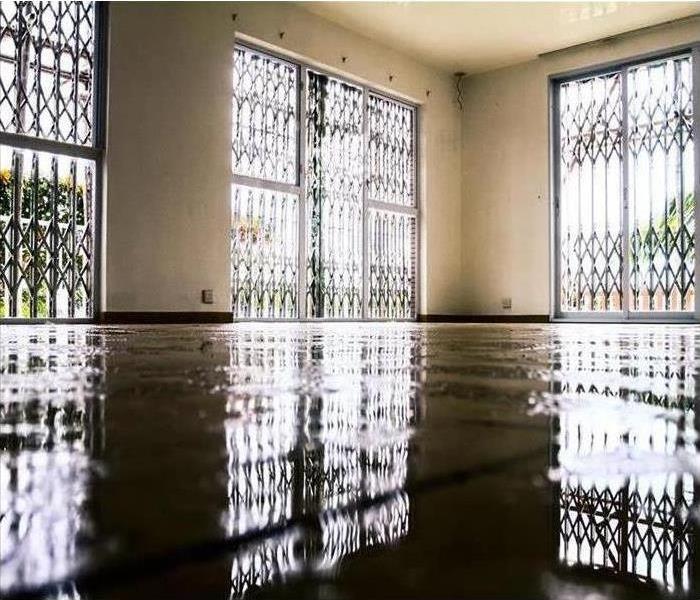 Don't undergo cleanup alone after your water loss. Trust SERVPRO of Midtown Manhattan to take care of your water loss right away!
Don't undergo cleanup alone after your water loss. Trust SERVPRO of Midtown Manhattan to take care of your water loss right away!
Can SERVPRO return my home to it's pre-water loss conditions?
Water damage in your Midtown Manhattan home can be mitigated by our SERVPRO team. Homeowners and renters can rest assured, our team will be able to quickly fix and correct any water damage. The result? Your home will be as good as new!
Why can’t I just fix the water damage myself?
SERVPRO of Midtown Manhattan uses commercial-grade equipment in all of our New York City water losses. We have more resources and professional grade options than anything available at a home improvement or renovation shop. Our trained technicians also follow a careful process that ensures we do not miss anything and provide a safe environment once again.
- Inspection and Assessment – Technicians and Project Managers examine the home to make certain we understand the damage extent and have the equipment needed for restoration.
- Water Removal & Extraction – We use pumps and smaller vacuum units to draw out the majority of the water in your home.
- Drying the Structure – Technicians use air movers and dehumidifiers to lower humidity and draw moisture out of structural property like wall framing and drywall.
- Cleaning and Sanitizing – Specialists clean off any debris that may have been brought up by the water and deodorize restorable items.
If you have water in your home, contact SERVPRO of Midtown Manhattan at (212) 768-9400 immediately. We are here to help you restore your home or apartment to a dry, safe condition.
Broken Pipes- What Homeowners Need To Know
1/11/2021 (Permalink)
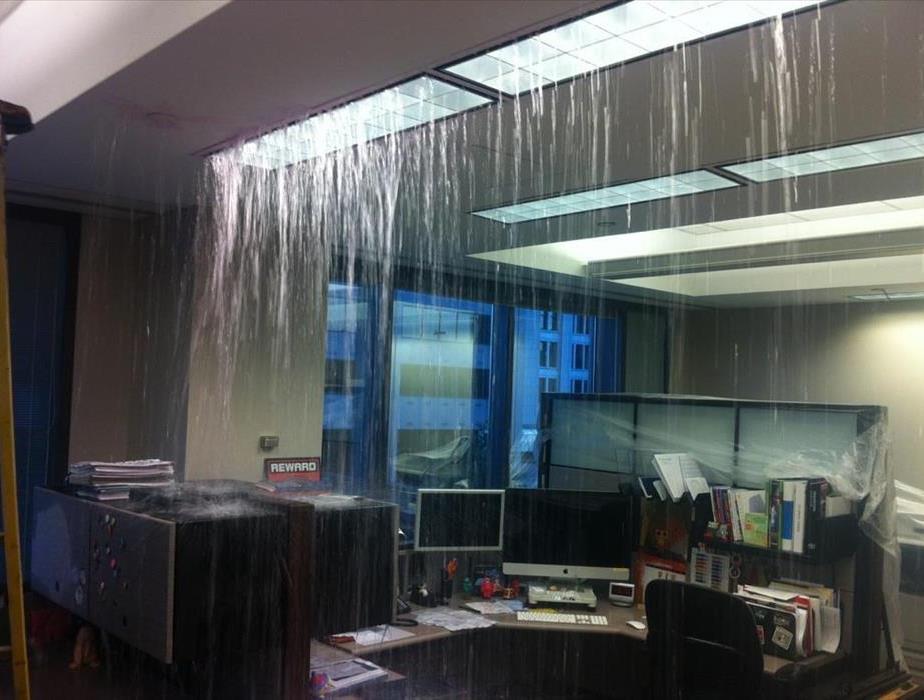 Broken pipes season is upon us. Here is everything you need to know in order to be prepared!
Broken pipes season is upon us. Here is everything you need to know in order to be prepared!
Burst Pipes: It happens more often than you would think. A burst pipe can cause NYC properties to flood in a short period of time, encompassing an entire property in just minutes. Many homeowners are overwhelmed with the water damage and often feel helpless.
While dealing with the effects of a broken pipe can be overwhelming, learning about broken pipes before an issue occurs can help NYC Property Owners take control and know what to do if it ever occurs in their home.
How Did My Pipes Break?
There are a variety of issues that can cause your pipes to break or burst. Common causes of pipe problems include:
- Rusted or old pipes
- Cold temperatures below 29 degrees F
- Improperly installed pipes
- A sudden increase in your pipes’ water pressure
Types of Damage
A burst pipe can have serious repercussions. One of them is mold growth. The growth of mold is a common issue in homes that have had pipe breaks. Why? Whenever there is moisture, there is the ability for mold growth. When a building undergoes pipe bursts, water damage is everywhere.
Additionally, building materials often deteriorate after a pipe break. Common surfaces that almost always need to be replaced upon water damage are laminate surfaces, drywall and subfloors.
The first thing a homeowner should do is call up a water restoration professional like SERVPRO of Midtown Manhattan. Technicians work to remove water and cleanup any signs of damage. The sooner our technicians are able to come in, the more confident you can be that your home is safe to come back to and no additional repair costs will accrue down the line.
Please note that a plumber is able to fix broken pipe and examine other pipes to check for widespread problems. Meanwhile, SERVPRO of Midtown Manhattan Restoration experts can focus on mitigating the damage that has already occurred and can help to restore furniture, documents, electronics and other items that could suffer.
Does Insurance Cover the Cost of Broken and Leaking Pipes?
Though insurance coverage may vary with individual policies, the majority of home insurance policies will generally cover the costs of broken or leaking pipes. If your apartment floods due to another tenant, it's important to get in touch with your insurance agency right away. It's important to connect with the other tenant to see if their policy will cover your property as well.
Some policies may not cover the costs of damage if it is not addressed right away. If broken pipes or other water damage occurs slowly over time, insurance companies will try to deny your claim.
Start Your Claim RIGHT Away
It's important to report right away, as most insurance companies will cover sudden breaks or leaks. To ensure you are fairly compensated, it can be helpful to provide your insurance company with documentation of the damage.
When a broken pipe results in a flood in your home, you may be unsure what to do next. By knowing what causes pipe breaks and what to do next can save homeowners both peace of mind and lower damage repair costs.
Give SERVPRO of Midtown Manhattan a call at 212-768-9400 for immediate help for all water pipe breaks, frozen pipes, or other water damage issues. Follow us on Instagram, Twitter, LinkedIn, and Facebook!
Signs of Water Damage
1/6/2021 (Permalink)
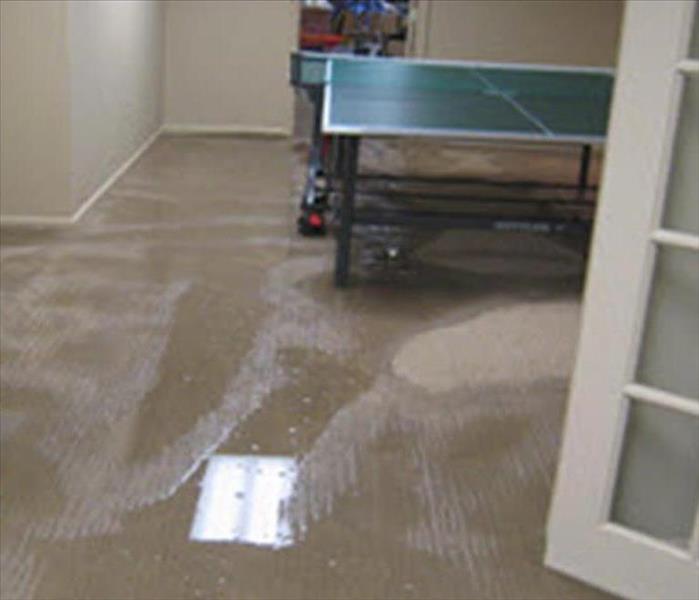 Follow These Tips to Avoid Water Damage! Need Water Restoration Services? Call us at 212-768-9400!
Follow These Tips to Avoid Water Damage! Need Water Restoration Services? Call us at 212-768-9400!
Most New York City homeowners state that its important to have a home inspection before moving in to their apartment, townhouse, or home. But, many of us neglect to investigate homes where we lived in years for signs of structural damage. In particular, it is critical to pay attention to signs of water damage.
For a property owners especially, water damage to their residential property is the biggest headache and consumes an enormous amount of time to resolve with the wrong restoration company
Here are signs you should look for to spot water damage early on.
- Changes in Floors, Walls and Ceilings
Many homeowners don’t notice the changes to structural elements. They are hard to spot in familiar surroundings even if you are good at cleaning up and upkeep. When water damage is on the cards, you can observe dry walls or ceiling being flaky. This condition if left unchecked, can become bloated. Tiles made of ceramic material often develop mold and cracks in the grout when damage by water.
- Running water sounds
Water damage isn’t always visible but make noticeable sounds. Drips, creaks in the floorboards and the sound of constantly running water may be signs that you need repairs. Small drips can result in holes in your concrete foundation, threatening the structure of the entire home.
- Increasing water bills
A sudden surge in utility bill is an ideal indicator of water damage on such occasion. Ensure to check the visible pipelines and faucets in the house for any leaks. If you fail to find leaks in the visible areas, consider the possibility of water damage inside walls.
If you spot any sign of water damage, call a plumber as soon as possible. You need to inspect you home regularly for signs of water damage to protect your family and your property.
Always treat a water damage seriously. Call in a professional like SERVPRO of Midtown Manhattan, we will work for you to restore your property.
If you notice water damage in your property, do not hesitate to call SERVPRO of Midtown Manhattan at (212) 768-9400.
Water Damage Classes
1/6/2021 (Permalink)
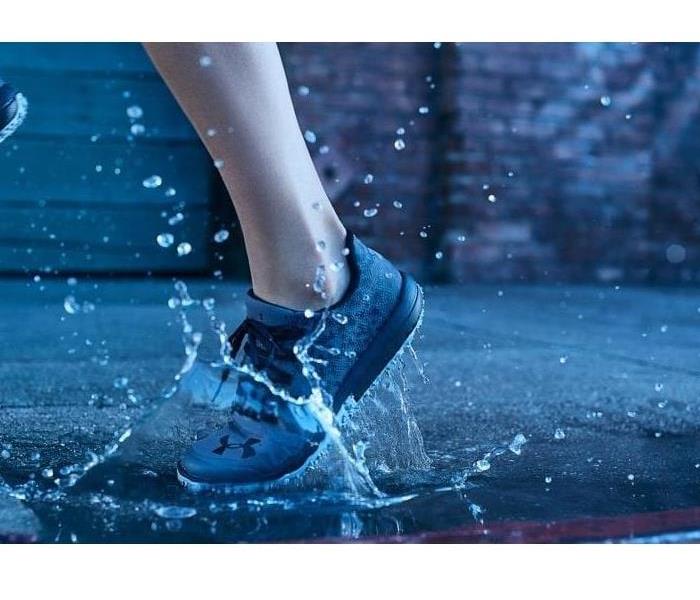 Learn about different classes of water damage from the experts at SERVPRO of Midtown Manhattan
Learn about different classes of water damage from the experts at SERVPRO of Midtown Manhattan
Did you know that there are different classes of water damage? SERVPRO of Midtown Manhattan technicians are well versed in this IICRC classification system, and we wanted to share so you can be better informed in case you ever have to deal with water damage in your home or workplace!
Classes of Water Damage Losses are determined by the rate of evaporation based on the type of materials affected by water damage to your property. Determining the Class of Water is an important first step and will determine the amount and type of equipment utilized to restore your business. Here are four IICRC water damage classifications:
Class 1 - Slow Evaporation Rate
Water losses that affect only part of a room or area, or losses with lower permeance/porosity materials (e.g., plywood, particle board, structural wood, vinyl composition tile or VCT, concrete). Little or no wet carpet or cushion is present. Minimum moisture is absorbed by materials, releasing moisture slowly.
Class 2 - Fast Evaporation Rate
Water losses that affect an entire room or carpet and cushion. Water has wicked up walls 12" - 24". There is moisture remaining in structural materials (e.g., plywood, particle board, structural wood, concrete).
Class 3 - Fastest Evaporation Rate
Water may have come from overhead. Ceilings, walls, insulation, carpet, cushion and sub-floor in the entire area are saturated.
Class 4 - Specialty Drying Situations
These consist of wet materials with very low permeance/porosity (hardwood, plaster, brick, concrete, stone, and crawlspace). Typically, there are deep pockets of saturation, which requires very low specific humidity.
Dealing with water damage? Don't go it alone! Call our office at 212-768-9400 for immediate assistance.
Appliances That Can Cause Water Damage
1/6/2021 (Permalink)
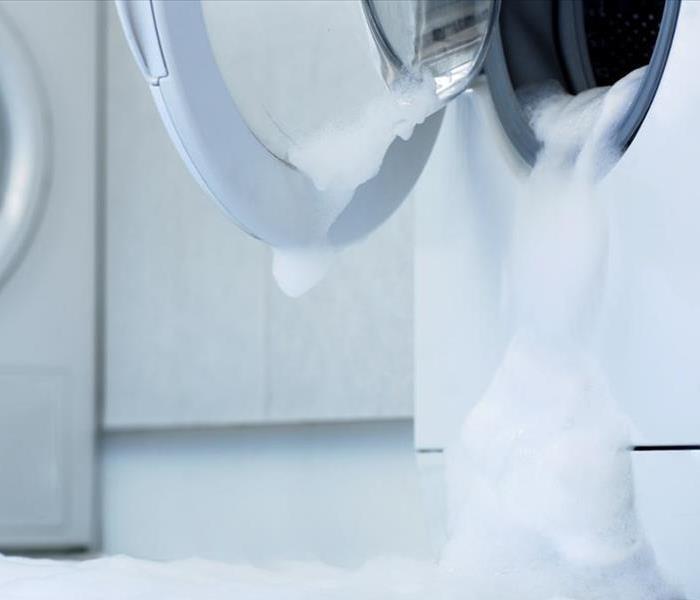 Routine Maintenance of your Household Appliances Can Save You Time and Money!
Routine Maintenance of your Household Appliances Can Save You Time and Money!
A common cause of water damage are leaks, spills, or flooding from common household appliances in NYC homes. To ensure that your appliances are in good working condition, we suggest that you get all of your appliances checked at a minimum of once a year.
Home appliances that need to be checked
Washing Machines
When a home washing machine happens to have a small leak, it can appear to be a small issue. Although a small leak seems to be a minor, it should not be ignored. We have experienced small pinhole leaks in a water supply line that have broken out into an all-out basement flood. For best safety practices to prevent water damage, it is best to check the connecting hoses leading to your washing machine a couple of times per year.
In some cases, our customers install an automatic shutoff valve to the water supply line for their washing machines. A shut off valve can help save a home from 500 gallons of water damage. Most water shut off valves on washing machines work because they automatically shut the water entering the washing machine once a full cycle is complete. The valve will remain closed until the next person is looking to wash the laundry.
Refrigerators
We all appreciate the convenience of an automatic ice maker in our kitchens. But did you know it can also be the culprit of household floods? Our SERVPRO crews have had to clean water damages caused by the water line that supplies an ice maker. When the water lines get damaged, they can leak or, worse yet, become completely unattached. We know it might be a hassle to get behind your home's refrigerator, but it is essential to waterline periodically for crimps and make sure the valve connection is secure. We recommend our customers leave a four-inch gap between the refrigerator and the wall for safety from water damage. This will allow easy access to pull out the fridge and prevent future crimping in your water line.
Dishwashers
The last known home appliance that can cause severe water damage comes from dishwashers. This household appliance has a supply line just like refrigerators and washing machines. If a dishwasher water supply line was to burst, you could guarantee that your kitchen will be filled with water after a wash and rinse cycle. In some of our more severe water damages caused by dishwashers, we have seen a dishwasher back up. Backup typically occurs when debris has clogged the drain, and the water has nowhere to go but inside your home.
SERVPRO of Midtown Manhattan highly recommends annual, routine inspection of the hoses and connections for your appliances. Doing so can save homeowners significant repair costs instead of handling a water loss claim.
If your Manhattan home falls victim to a water emergency, time is of the essence. Contact SERVPRO of Midtown Manhattan at 212-768-9400 for immediate water restoration assistance.
What Causes Burst Pipes and What Should I Do??
10/16/2020 (Permalink)
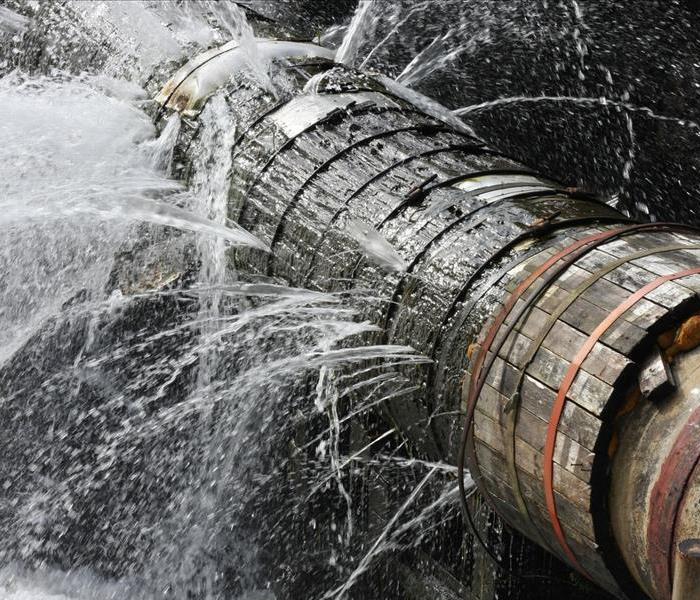 Pipes bursting are a common issue for NYC homeowners and tenants in the colder months.
Pipes bursting are a common issue for NYC homeowners and tenants in the colder months.
What Causes Burst Pipes?
Burst pipes are a common occurrence in New York City as the colder months set in. Many residents and workers are in buildings where the pipes are potentially older than their grandparents! It sounds like a car backfiring, this loud pop sound, when these water pipes burst. The result is major flooding in the home and structural damage problems for homeowners. SERVPRO of Midtown Manhattan has compiled a list of the four main reasons why burst pipes occur:
- Frozen Pipes
- Moving Pipes
- Water Pressure
- Corrosion
Frozen Pipes
In the Winter months, serious issues arise for the water supply pipes in the home. Cold temperatures generally cause contraction to occur. Ice has more volume than water, so when water freezes inside a pipe it expands and increases pressure inside the pipe. The pressure builds, and needing to escape it’s forced to burst out of the pipe. The burst will occur at the weakest point in the pipe, with pressure bursting right out of the side of the pipe wall.
To prevent frozen pipes, make sure that your home never goes below 55 degrees Fahrenheit. Open your cabinet doors below the sink to allow warm air to circulate around the pipes as well.
Moving Pipes
Pipes can actually move around within the walls if they’re not properly secured AND the water is suddenly turned on or off. One way to know for sure is if you can hear your water pipes making noise inside the walls or floors. If your pipes sound like they’re clanging against each other, it’s called a water hammer. What you’re hearing is that the pipes are moving back and forth due to not being held into place properly. Gradually, these pipes become weakened in the joints until one pipe fails and pressurized water has a crevice to escape from. This causes the water pipe to break and flood an entire floor within a few moments!
Water Pressure
Water pressure must be kept at a normal setting in order for your water supply pipes to function properly. Any noticeable increase in the water pressure can translate to a burst pipe. It can also lead to a sink, toilet, or tub. As pressure increases, the pipes will cave in and separate, causing a rupture. Think your water pressure is getting too high? Here’s what to do!
- Monitor it by attaching a pressure gauge to a sink spout and turning on the faucet. The pressure will move the needle on the gauge and display the water pressure in psi (pounds per square inch).
- The water pressure in most homes is between 30-50 psi to avoid damage to pipes and plumbing fixtures.
- If your home’s water pressure is too high, a SERVPRO technician can install a pressure reducing valve to bring it down to safer levels.
CORROSION
Pipes are meant to last a long time and provide decades worth of reliable service, but they aren’t able to last indefinitely. Over time, buildings experience corrosion which can mean that pipes will show signs of failure or decay. Corrosion is caused by an imbalance of pH in the water. At first, this seems to be a minor issue, but it takes its tolls on the pipes over the years.
Many water supply pipes are made of galvanized iron, the minerals inside the water slowly wear down the galvanized coating and expose the iron pipe beneath. In time, the iron turns to rust and gradually clogs the interior of the pipe which prevents water from getting through. As a result, your pipe may burst or the water flow may be stopped entirely.
What Should I Do Now?
If you experience a burst pipe, the first step is turn off the Water Main. Then, be sure to call a professional from SERVPRO of Midtown Manhattan to remediate the water damage and to determine the cause of the burst pipe. Why is it important? Early detection and annual checkups can help prevent this issue from happening again in the future. Our team of experienced water remediation technicians are able to assist in giving tips for preventing water damage in addition to offering cleanup services.
If this happens to your building, don’t worry. Our team will be on site as soon as possible to start removing water and determining the source of damage to prevent future disasters. We know that burst pipes are unexpected and downright terrifying, but leave it to us to get it fixed promptly. We’re able to remove water quickly so you won’t have to replace everything and you can go back to your daily routine as soon as possible.
Trust the #1 Name in Water Restoration for New York City and call SERVPRO of Midtown Manhattan at (212)768-9400 for water restoration needs.
Buckled Floor? Call us ASAP!
1/14/2020 (Permalink)
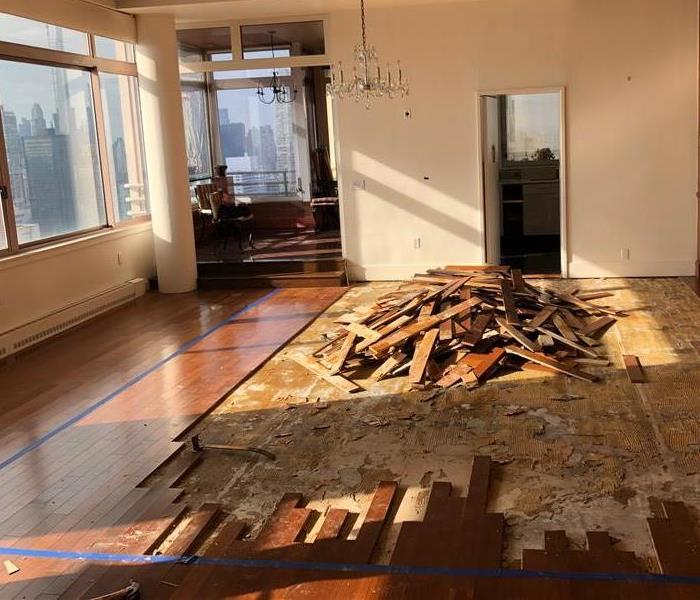 Floor buckling happens most often after a floor has been flooded for an extended period.
Floor buckling happens most often after a floor has been flooded for an extended period.
What Causes Hardwood Floors to Buckle?
Floor buckling is the most extreme reaction to moisture in a hardwood floor. Buckling occurs when the wood flooring pulls up from the subfloor, lifting several inches in one or more places. Fortunately, this is not a common occurrence.
If caught early, spot repair and replacement may be possible. Once the standing water is removed, several boards can be taken up from the floor so that the air can circulate across and below the floor. When the floor has dried to a more stable moisture level, repairs can usually be made.
What can SERVPRO of Midtown Manhattan do?
- Set up floor protection, drying mats and drying equipment
- Wear PPE
- Clean all affected areas
- Content Manipulation, full Pack out and Storage
- Removal of buckled floorboards
Additionally, our upcoming Reconstruction Division will be able to replace the flooring for you, professionally. Call SERVPRO of Midtown Manhattan today at 212-768-9400!
Water dripping from your ceiling or visible signs of water damage on the drywall or plaster above your head is nothing to take lightly.
1/13/2020 (Permalink)
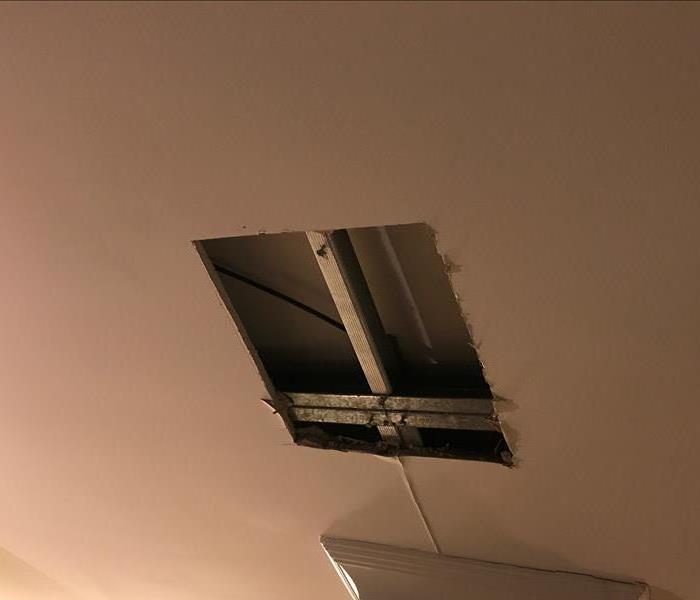 There may be more water at play than you can visibly see and ignoring a leak can lead to structural damage and mold and mildew growth.
There may be more water at play than you can visibly see and ignoring a leak can lead to structural damage and mold and mildew growth.
Water coming from the ceiling is a symptom of some other home system that is leaking. When a ceiling shows signs of water damage and dripping water, the place to look is in one of two home systems: the roofing system or the plumbing system. Ceiling leaks may be evidenced by actual water dripping down, but before the problem escalates to that point, you may see blistered or peeling paint, or discoloration over a spot in the ceiling.
Identifying Roofing System Leaks
If there are signs of water damage or dripping water coming from the ceiling that is directly below an attic space or directly below the roof surface itself, there is almost no question that the true cause is a hole or other type of damage in the shingles or other roofing material that make up the roof system. There are rarely any plumbing pipes or fixtures running through an attic, so signs of water damage in a ceiling below an attic or roof are always caused by a roof problem. In addition, roofing system leaks will make themselves known through other symptoms:
- The leaking occurs during or shortly after a rainfall. It may take some time for the water to appear, but if it appears during or after a rain, the roof is the place to look for the source.
- If there is active water dripping, it will often be brown or dirty if it comes from the roof. Water making its way into your home often picks up dirt and impurities along the way.
- In cold climates, if ceiling leaking or damage coincides with the presence of ice buildup along the eaves of the house, you likely have ice dams that are causing ice and water to back up under the shingles and down onto the ceiling. Because ice dams occur along the edges of the roof, the ceiling damage or leaking is often near the edge of the room, or may even appear on an exterior wall, since the water may be dripping directly down into the walls.
- In the attic, you may find damp and soggy insulation. Gain access to the attic and look for areas of insulation that show signs of wetness. Do not assume, however, that the roof damage is directly above this part of the attic, because water can flow for quite some distance down along sheathing or a roof rafter before it drips down onto the insulation and through it to the ceiling surface. If you spot damp insulation, pull it back and examine the drywall or plaster lathe beneath. It may be obvious that you've found the source of the ceiling leak.
SERVPRO of Midtown Manhattan cleans your HVAC unit as if it were our own.
1/12/2020 (Permalink)
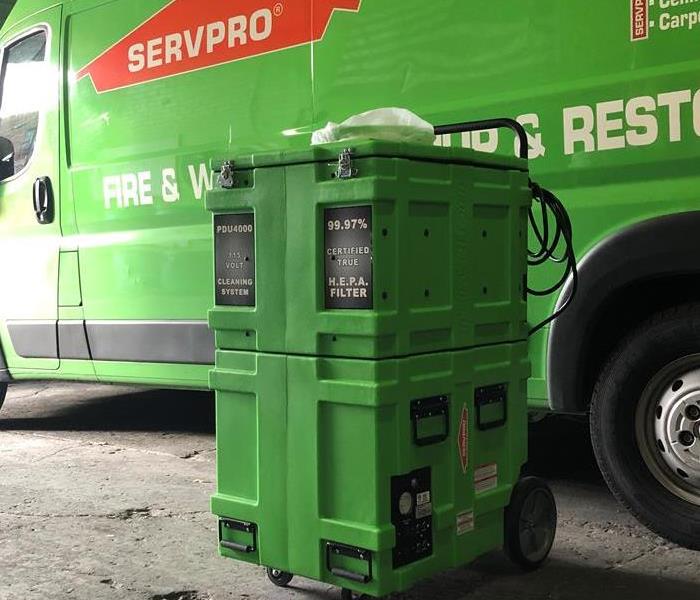 HVAC maintenance cleaning overdue? Leave it to the experts, call SERVPRO of Midtown Manhattan!
HVAC maintenance cleaning overdue? Leave it to the experts, call SERVPRO of Midtown Manhattan!
Residential Air Duct Cleaning in New York
As anyone who owns a home knows, you constantly strive to keep things clean – frequent dusting, upholstery cleaning, and floor maintenance are typically the first items that come to mind. However, an often-overlooked cleaning issue is air duct maintenance – many people are unaware of the harm that a neglected air venting system can cause.
After years of use, the ducts accumulate an innumerable amount of debris, including layers of dust, pollen, contaminants and other pollutants that can affect your air quality. Furthermore, air ducts that aren’t cleaned regularly are more prone to burn out and malfunction.
Ready to schedule an appointment or have other questions about our services?
When you clean your air ducts, the inhabitants of your residential property will experience several benefits, particularly those who suffer from allergies or other respiratory disorders. According to the Environmental Protection Agency (EPA), air ducts should be cleaned once every 2 years to prevent potential health risks.
Whether you live in a New York apartment complex or own a residence elsewhere in New York, SERVPRO of Midtown Manhattan provides a host of green cleaning alternatives, including all-natural air duct cleaning services. Our team of certified professionals combine the latest technology with an eco-friendly approach with our upcoming HVAC cleaning division.
Call SERVPRO of Midtown Manhattan today at 212-768-9400!
Protect your Employees, let SERVPRO of Midtown Manhattan clean your ducts!
1/12/2020 (Permalink)
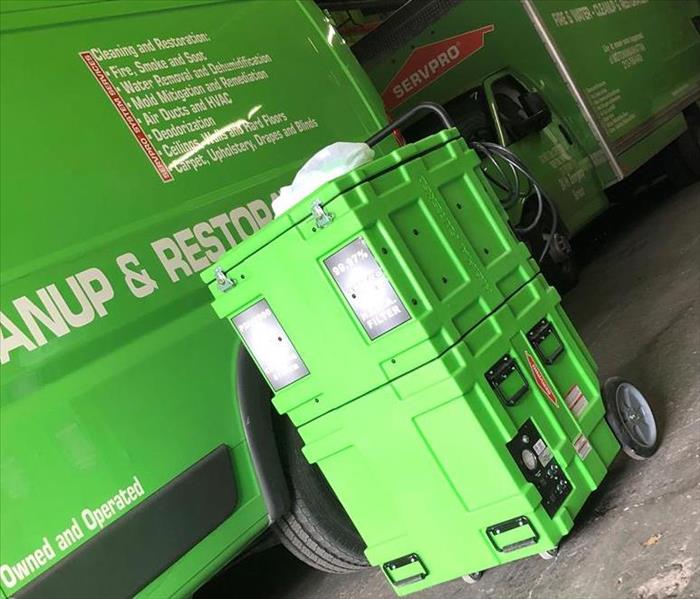 If you are looking for Commercial Air Duct Cleaning in New York, you’d better address the professionals – SERVPRO of Midtown Manhattan is your expert.
If you are looking for Commercial Air Duct Cleaning in New York, you’d better address the professionals – SERVPRO of Midtown Manhattan is your expert.
Cleaner, Greener Air
If you clean your air duct system incorrectly or use improper tools, you can worsen the condition of your air quality. At SERVPRO of Midtown Manhattan, we’ve developed a targeted approach for cleaning your air vents – we only use the highest-rated equipment and environmentally friendly cleansers to safely, yet effectively, purify your air ducts.
As a result, you will note a marked improvement in air quality as cleaning your air vents is essentially safeguarding the health of your occupants. In addition, our team of air duct cleaning specialists will assess the condition of your venting system if you believe there are any pre-existing conditions (such as mildew, mold growth, etc.).
CLEANER AIR. HEALTHIER WORKPLACE.
If you think the air you breathe indoors is cleaner than what’s outside, think again. The indoor air can be two to five times more polluted than outdoor air. When dust, debris and other contaminants build up in your heating, ventilation and air conditioning (HVAC) system, they can trigger allergies and other health issues. But they also reduce energy efficiency, which increases your energy costs.
After we have completed the evaluation and inspection, we develop and provide our customers with a scope-of-work document, outlining the work to be performed and a time frame for completing it. Next, our certified technicians use powerful equipment to remove the pollutants. SERVPRO of Midtown Manhattan's upcoming HVAC cleaning division will systematically clean every component of your Commercial building’s ventilation system.
We maintain an open line of communication with all Centers of Influence throughout the entire cleaning process. Our goal is to contain the work areas, ensuring minimal disruption to your business operations. After SERVPRO of Midtown Manhattan's air duct cleaning is complete, we conduct a final inspection and provide each customer with daily progress reports throughout.
As always, only trained SERVPRO of Midtown Manhattan employees in our HVAC division will perform the work. It’s an approach that differentiates us from the rest because we want you to be completely satisfied with the results and make "Like it never even happened."
Call SERVPRO of Midtown Manhattan today 212-768-9400.
What Should NYC Residents Do When a Pipe Bursts in Your Home?
1/10/2020 (Permalink)
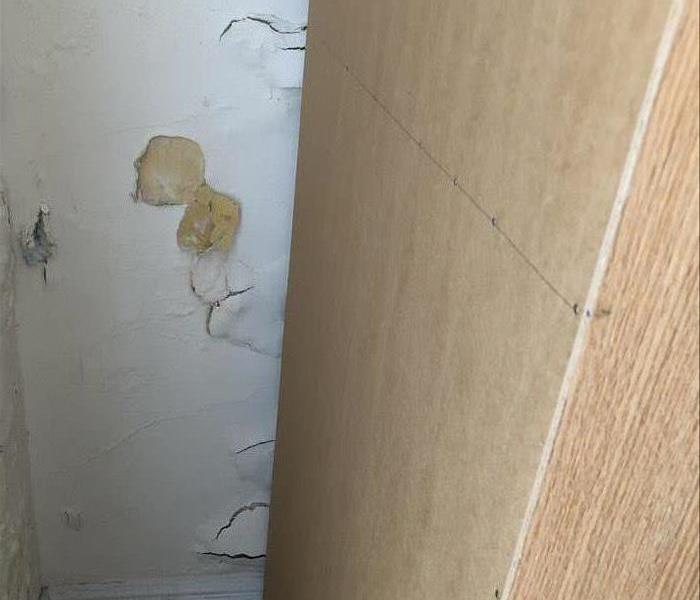 When a pipe breaks in the house, every second counts. We highly recommend you take time now to become more familiar with your home’s plumbing!
When a pipe breaks in the house, every second counts. We highly recommend you take time now to become more familiar with your home’s plumbing!
WHAT DO YOU DO WHEN A PIPE BURSTS?
Follow these steps to control damages from a broken pipe:
- Immediately turn off your home’s water supply at the main cutoff valve.
- Drain pipes by running cold water faucets and flushing toilets.
- Locate and fix the break with epoxy putty or a pipe repair clamp.
- Thoroughly dry affected areas by running fans for approximately 2-5 days depending on the severity.
If repairs and cleanup turn out to be more than you can handle, contact your insurance company. Most homeowner policies cover burst pipe water damage, and you should let your agent know you'd like to hire SERVPRO of Midtown Manhattan.
GIVE US A CALL
We’re all enjoying a warm January here in New York City, but it’s best to be prepared for the unexpected. By knowing what to look for, what to do and who to call, you minimize problems from ruptured pipes on a winter day.
Our teams are always ready to help you with busted pipes, water damage and repairs. We take care of it all, and we also offer certified mold remediation services. When a broken pipe at the house tries to ruin your winter, give us a call here at SERVPRO of Midtown Manhattan!
Water Damage is Oftentimes Better Left to the Professionals
1/8/2020 (Permalink)
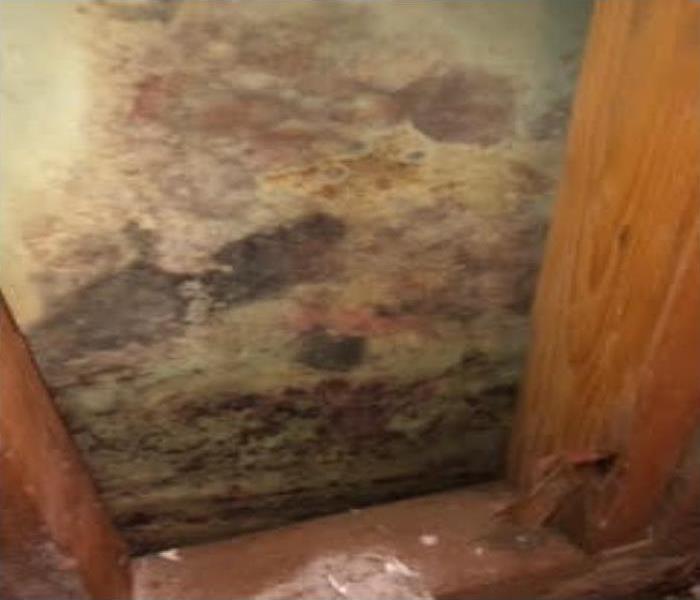 It’s completely natural to want things to go back to the way they were after your residence or business is devastated by water damage.
It’s completely natural to want things to go back to the way they were after your residence or business is devastated by water damage.
Did You Know There Are 3 Varieties of Water Damage?
If you’re dealing with anything other than a large incursion, you understandably may be considering handling the cleanup and drying yourself to save money or time. The problem with doing it yourself is that cleaning up and recovering from water damage isn’t always as straightforward as it seems.
Which is why we have highlighted 3 key things you need to be aware of when addressing water damage from a minor clean water incursion or Category 1 water loss.
1) Know What You’re Dealing With
Water damage can be caused by three different types of water, including:
I. Clean water (Category 1)
II. Gray water (Category 2)
III. Black water (Category 3)
It’s important to understand the differences between all three categories because Category 2 and Category 3 water will present health risks to your employees, customers and loved ones. All three categories need to be handled differently.
The most common sources of clean water damage typically occur from a pipe, water heater, steam lines or even rainwater. The basic rule of thumb is that it should look and smell like tap water. Recovering from Category 2 or Category 3 water damage or heavy flooding involves additional considerations.
A Category 2 water loss, aka “grey water” refers to a source of water that contains a significant degree of chemical, biological, or physical contaminants and causes discomfort or sickness when exposed or consumed. This type of water damage carries microorganisms and nutrients of microorganisms. Category 3 water loss involves water that is grossly contaminated and can contain pathogenic, toxigenic, or other harmful agents. Such water may carry silt, organic matter, pesticides, heavy metals, regulated materials, or toxic organic substances.
2) Make Sure You Investigate All of the Damage
The challenging thing about recovering from water damage from something like a broken pipe or rainwater incursion is that you can typically only see a small part of the actual damage. The majority of the moisture is often hidden in walls, and it’s critical to identify and dry all of the affected areas to prevent a different issue, mold. The methods for dealing with damage to walls depend on the type of materials and what’s behind those materials. Drywall can often be salvaged, when you respond quickly to said damage.
SERVPRO of Midtown Manhattan uses moisture meters that allow us to assess structural integrity. If the integrity checks out, then our drying approach will depend on wall contents. If the wall has insulation, we will use flood cuts. If there is no insulation, then usually the best method is to create access holes. And if you’re dealing with a firewall, we will use staggered cuts. We may even need to remove your base molding and flooring materials. If your floors are carpet, we may be able to pull back the wet area and dry it using a fan.
3) Establish Proper Airflow and Keep the Windows Closed When Drying
Once moisture is discovered, your first instinct may be to open windows to help with the drying process. However, it may not be your best move. For example, if your building is mechanically ventilated, the systems need constant pressure levels to work correctly. You also want to avoid excess coolness or heat and humidity, or you may end up complicating the drying process.
Once we’ve pulled away wet materials and established holes or cuts in the wall as needed, we will begin placing our drying equipment. To prevent mold, make sure all the layers and materials are dry before putting everything back together.
The Big Dry Out
If you’ve experienced water damage, hopefully you’re dealing with clean water and a small area. No matter what type of water damage you’re dealing with, don’t hesitate to call us. SERVPRO of Midtown Manhattan is here to help!
Call our Office, 212-768-9400
Worried about your personal belongings during a flood? We've got you covered!
1/7/2020 (Permalink)
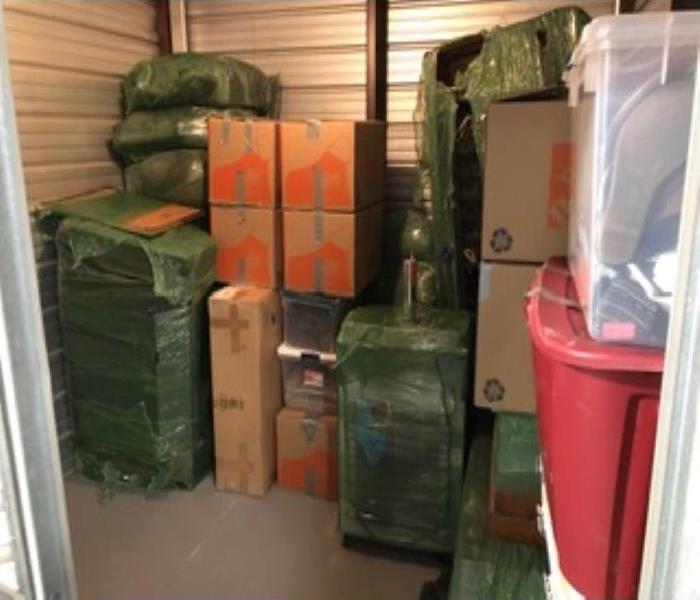 SERVPRO of Midtown Manhattan specializes in handling the items inside your home or office during the stressful restoration period.
SERVPRO of Midtown Manhattan specializes in handling the items inside your home or office during the stressful restoration period.
There are 3 phases regarding your content SERVPRO of Midtown Manhattan will take to restore your property.
- Pack Out- Our Content Specialist will properly inventory, package, move and store your belongings to ensure minimal damage is brought onto your personal property during the unforeseen loss you just encountered.
- Content Cleaning- Our Cleaning Specialists are highly trained and certified professionals whom are knowledgeable of the various types of content and the appropriate cleaning procedures, as well as, the environmental factors that affected them.
- Content Inventory- During the damage analysis, home item inventory, pack-out and resetting stage of our services; our highly trained Inventory Specialists will obtain photos every step of the way and create an inventory of what was salvageable and what was unsalvageable.
With a focus on limiting the damage, we’ll work quickly to protect your property. Throughout the entire process we will work directly with your insurance agent or adjuster on your covered loss for a streamlined and expedited process.
What will SERVPRO of Midtown Manhattan do with my personal property?
- Professional and Concise Inventory of Contents
- Pack Out and Moving Services
- Specialized Cleaning and Decontamination of Contents
- Contents Repair and Restoration
- Secure Contents Storage
- Thorough and Accurate Pack-Back and Reset Services
Do you or a loved one need the contents of your property professionally inventoried, packed up and stored in a safe and secure facility?
Don’t hesitate! Call today! 212-768-9400!
Do Pipes ONLY Burst in the Winter?
1/3/2020 (Permalink)
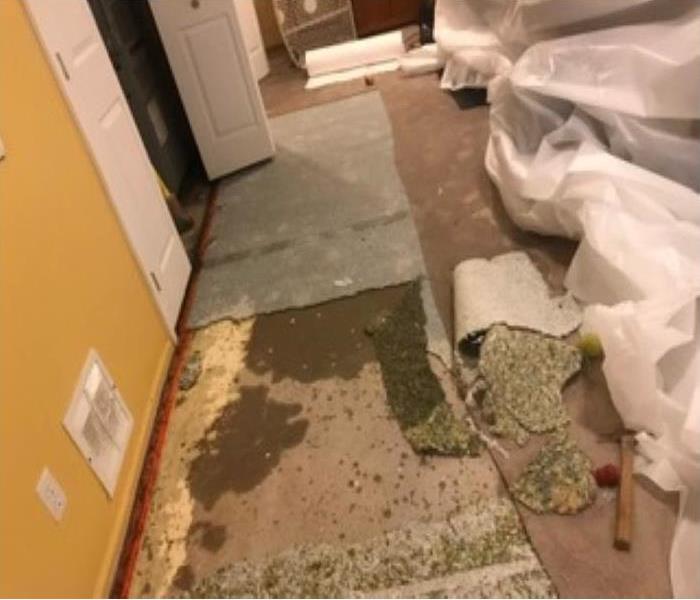 Water systems come in all different shapes and sizes, but all share one characteristic: they can fail when temperatures get extreme.
Water systems come in all different shapes and sizes, but all share one characteristic: they can fail when temperatures get extreme.
Cold weather causes water pipes to freeze and eventually burst. Due to the pressure of unfrozen water between the ice and the closed faucet heightening, the metal splits. This phenomenon can happen in warmer climates, as well. When colder air passes by the warm water in the pipes, pressure is created, and boom! The pipe ruptures.
Cold weather is not the only cause of water pipe failure. Warm weather also causes thousands of pipes to burst each year. During the summer months heat related water main bursts are at peak levels. Even if your pipes are underground, they are not safe from extreme temperatures.
Have you ever noticed that in the summer months there seems to be roadwork going on everywhere? Some of that is due to underground water pipes rupturing due to the heat. Most towns and cities keep extra roadwork crews readily on call to deal with this problem.
A good way to tell if the heat is affecting your pipes is by feeling the temperature of you water. If you turn on the cold water and you feel lukewarm to hot water coming out for several minutes, chances are your water pipe has already begun to leak or has gained pressure.
Before you freak out, call your local certified Restoration Company, SERVPRO of Southern Staten Island at 718-979-4100.
What Should NYC Residents Do When a Pipe Bursts in Your Home?
1/3/2020 (Permalink)
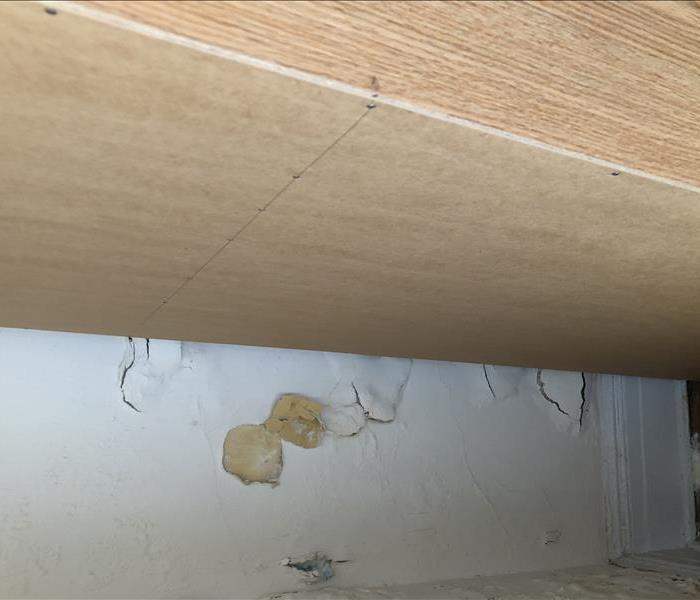 When a pipe breaks in the house, every second counts. We highly recommend you take time now to become more familiar with your home’s plumbing!
When a pipe breaks in the house, every second counts. We highly recommend you take time now to become more familiar with your home’s plumbing!
WHAT DO YOU DO WHEN A PIPE BURSTS?
Follow these steps to control damages from a broken pipe:
- Immediately turn off your home’s water supply at the main cutoff valve.
- Drain pipes by running cold water faucets and flushing toilets.
- Locate and fix the break with epoxy putty or a pipe repair clamp.
- Thoroughly dry affected areas by running fans for approximately 2-5 days depending on the severity.
If repairs and cleanup turn out to be more than you can handle, contact your insurance company. Most homeowner policies cover burst pipe water damage, and you should let your agent know you'd like to hire SERVPRO of Midtown Manhattan.
GIVE US A CALL
We’re all enjoying a warm January here in New York City, but it’s best to be prepared for the unexpected. By knowing what to look for, what to do and who to call, you minimize problems from ruptured pipes on a winter day.
Our teams are always ready to help you with busted pipes, water damage and repairs. We take care of it all, and we also offer certified mold remediation services. When a broken pipe at the house tries to ruin your winter, give us a call here at SERVPRO of Midtown Manhattan!
Most people know that when their water heater is leaking, it means bad news.
1/3/2020 (Permalink)
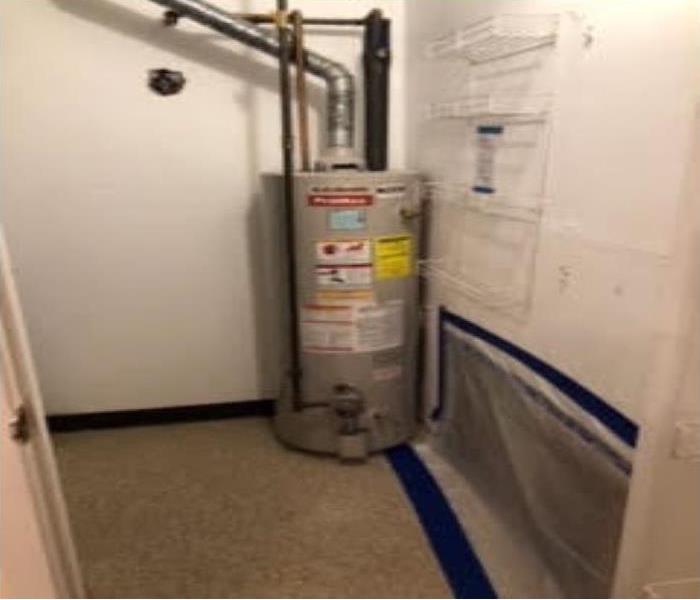 This minor nuisance can turn into a significant problem before you know it, so it is something that should be handled quickly and professionally.
This minor nuisance can turn into a significant problem before you know it, so it is something that should be handled quickly and professionally.
A small trickle of water can be easily cleaned up with minimal damage to your floors. However, this small trickle will soon turn into a flood that will cause damage to your sub-floors and even dry wall. Therefore, it is of the utmost importance to quickly and effectively diagnose where the leak is coming from and how great the threat is of causing a more severe problem.
You may be able to determine yourself if the leak is an easy repair, or if you require a brand-new water heater. Regardless of your findings, we recommend always contacting a licensed plumber to look at the issue and either fix the leak or replace your water heater altogether. A plumber will look at two main areas to determine once and for all where the leak is coming from and how serious it is.
Below is a list of the four most probable causes of a leak in your water heater. You can inspect these areas yourself before contacting a plumber to give them an idea of what is wrong and what equipment they will most likely require repairing or replace your water tank.
The Cold and Hot Water Inlet and Outlet Connections:
- If this area is the source of your leak, it is a very easy fix. Simply check the inlet and outlet pipe's connections and see if they are loose and causing water to leak. If this is the case, you may just need to tighten the connection with a wrench or replace a faulty pipeline.
The Temperature and Pressure Relief Valve:
- The temperature and pressure relief valve play an essential part in keeping your water heater running smoothly. It is responsible for monitoring the water temperature and pressure within the tank.
- If there is too much pressure in the tank, or the water becomes too hot, this valve will drain some of the water out of the tank.
- If this T/P valve is the source of your leak, you will most likely be able to see water running down the side of your tank from the valve.
- If this is the case, it could mean you need a new valve because the one you currently have is broken, or, it could also mean it is working properly and there is too much pressure in your water tank, so it is forcing water out through the T/P valve to prevent a bigger problem from occurring.
- A licensed plumber can determine which one of these scenarios is the cause.
The Heater Drain Valve:
- As previously stated above, the drain valve is a standard but an easy issue to repair. If water is leaking from the valve, make sure it is closed completely. If this watertight drain valve continues to leak, you may have to replace it entirely, but it is relatively inexpensive.
The Bottom of the Water Tank:
- Lastly, the most common cause of a leaking water tank. As discussed above, when sediment builds up in the bottom of a water tank for years and years it will eventually corrode through the bottom of the tank and begin to leak. If age and deterioration is the cause of your leak, you will need to call a professional plumber to replace your water heater.
No matter the extent of damage caused by the leak or what you believe the issue with your water heater is, we always recommend that you call a professional and licensed plumber to double check the source of the leak and make necessary repairs or replacements.
We also highly recommend you contact your local, professional and certified Restoration Company, SERVPRO of Midtown Manhattan to make the water damage disappear after the repairs!
Our office phone number is 718-979-4100
Water Damage Can Be Expensive, Insurance Coverage Can Help!
1/3/2020 (Permalink)
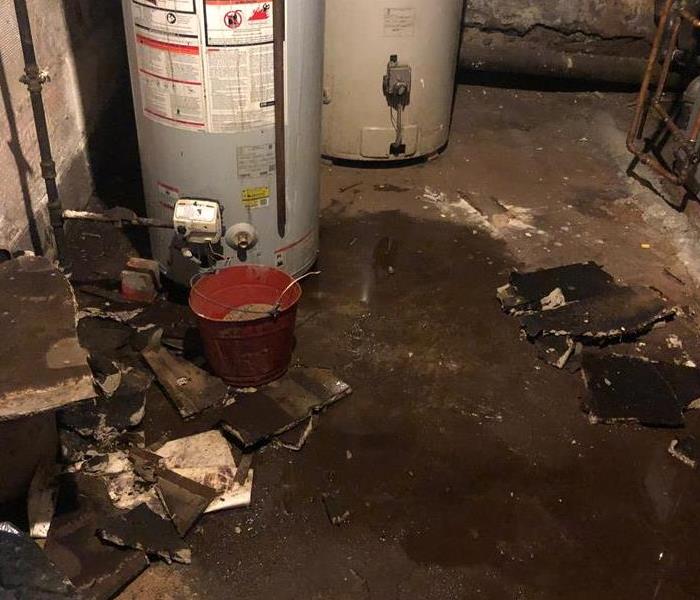 You want to make sure your business can be helped in the event that water damage occurs. Not all commercial insurance policies are the same, though.
You want to make sure your business can be helped in the event that water damage occurs. Not all commercial insurance policies are the same, though.
Insurance Coverage for Commercial Water Damage
It can be expensive to pay for the cleanup and restoration of water damage, which is why it’s important to have thorough commercial water damage coverage from your insurance provider.
Water damage can be sourced in so many ways and the coverage differs among available commercial insurance policies depending on the cause. You may need to add water damage coverage or get additional coverage on top of the standard policy to cover a greater range of water damage sources. When getting quotes, pay attention to what different companies offer and inquire about what the coverage options are for water damage.
Leaks and burst pipes are among two of the more common causes for commercial water damage, so business owners should especially make sure their policies cover such damage. However, slow, gradual leaks often aren’t covered by commercial property policies. This is because companies see this as negligence, something that could have been prevented with proper maintenance unlike an accident, which happens suddenly and could not have been avoided.
Keep this all in mind when choosing what commercial insurance to get for your business. If you already have a business and commercial insurance for it, look over your policy. Review the coverage to see whether your business is protected against water damage and to what extent. Contact your insurance agent, and inquire with them what additional coverage, if any, you can get to further protect your business. While no business owner wants to deal with water damage, it’s better to be safe and have that insurance than to find yourself unprotected.
If your business ends up suffering from water damage, then you need to seek immediate assistance from a professional restoration company like SERVPRO of Midtown Manhattan, that helps restore damage in commercial properties.
Our professional technicians will begin their work by containing the damage to prevent it from spreading further and becoming worse. Furthermore, they always have the correct equipment to properly dry your commercial property and restore or replace any damaged building materials. If mold has grown as a result of the water damage, our technicians can address that problem as well.
Call SERVPRO of Midtown Manhattan today at 212-768-9400!
The longer your belongings stay in water, the worse the damage will be.
1/3/2020 (Permalink)
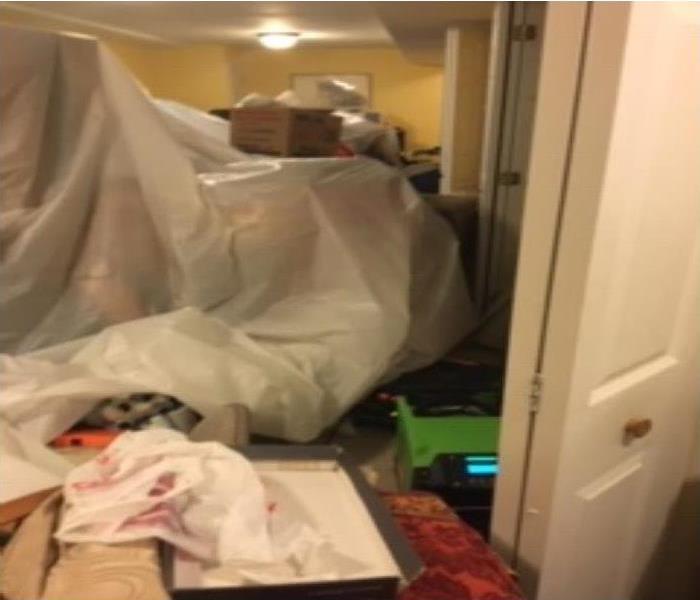 Any area that is not dried thoroughly within 24 hours may have long-term mold problems
Any area that is not dried thoroughly within 24 hours may have long-term mold problems
Do you have the time?
Do you have the expertise?Flood damage cleanup is a multi-stage process. First, the floodwater must be pumped out and the area thoroughly dried. During this process, you will need to mitigate safety concerns due to the weakened structure of your home. There will also be health hazards as you will have to deal with bacteria and mold. You will have to decide which of your possessions can be saved and what must be thrown away. Only then can you begin the actual flood repair work to make your home livable again.
Do you want to do the work?
Flood mitigation is dirty, often hazardous work. After the flood is over, do you want to face cleaning contaminated water and mud out of your home, then sort through your possessions to see what can be saved? The emotional impact of flood cleanup can be significant, and can interfere with other aspects of your life. Hiring a professional, like SERVPRO of Midtown Manhattan, to do flood damage restoration is an investment in your mental and emotional health.
Finding a reliable, qualified flood restoration company doesn’t have to be complicated. SERVPRO of Midtown Manhattan is your leading professional, trustworthy and certified Restoration Company for NYC!
Check out our website at www.SERVPROmidtownmanhattan.com, and call our office at 212-768-9400!
Water Damage in Drywall
8/6/2019 (Permalink)
Drywall is a fundamental part of your home, in the event of a water damage though it is often forgotten. While the material is fairly durable, a leak can wreak havoc on it. Because of the porosity it can wick up water and become problematic. Areas affected by this are prone to mold and become more serious then they started out. In these cases it is necessary to contact a company such as SERVPRO to remove and treat the issue at hand. Do not leave yourself at risk and always deal with water damages promptly.
importance of properly handling water damage
1/30/2019 (Permalink)
importance of properly handling water damage
Water damage causes huge headaches for home owners and is sometimes immediately evident, but occasionally more slow forming. Sometimes the evidence of burst or leaky pipes is even discovered after returning from a trip. Regardless whether the water damage stemmed from a pipe issue, plumbing issue, HVAC problem, or faulty appliance, it is important to quickly contact a home restoration specialist company when water damage is discovered.
Contact a company equipped and available to help with water emergencies at any time of day or night. Time is of the essence and making a phone call will help to organize your thoughts and information as you move forward with safety concerns and insurance tasks. Professionals like the SERVPRO team have a wealth of experience, certifications, affiliations, and awards. They assist customers in NYC by quickly assessing the level of damage and contamination to any home. They also inspect carpet and know how to extract and dry water and moisture out from not just easy to see areas, but also from hidden areas. For example, they use professional grade pumps, dehumidifiers, infrared cameras, and cleaning and sanitizing products.
If you need water damage assistance in New York, the caring and efficient team from SERVPRO is always available. In addition to assessing damage, extracting water, and drying areas, they also assist with cleaning belongings. They help to eradicate the unmistakable odor associated with water damaged items. They also work together with insurance companies to properly get rid of damaged materials and handle other parts of the process. While water damage situations are understandably overwhelming, remember that you are not alone and professionals are ready and willing to help with every step.
Common Causes of Water Damage
1/23/2019 (Permalink)

A homeowner needs to be cognizant of the risks of flooding and take measures to avoid it in anyway possible. This is because flooding can be significantly damaging to your home. When flooding occurs a homeowner should be prepared to take quick action to reduce the long-term damage that the flooding causes.
Causes of Water Damage
Water Damage comes from several different sources. Flooding in your home can’t be the result of general races in the sea level that flood into your basement at home. Hurricanes another storms can also cause flooding and an increase in the overall water level. Homeowners can have water pipes freeze and break in there for contribute to flooding. General rain can also see been to your home only to flooding.
Problems Associated with Water Damage
Water can be incredibly damaging to your home. Floodwater can damage your personal possessions, lead to the growth of mold colonies which can damage your homes value as well as your health, and lead to electrical fires. The problems associated with water damage or even more severe when you were talking about saltwater which kind a rude your homes interior and wiring and pose a significant risk of fire. It is essential for homeowner to resolve water damage as quickly as possible and to take steps to prevent it from occurring in the first place whenever possible
How to Handle Water Damage
When flooding occurs in your New York home it is essential to address it as soon as possible. To what extent you can, mop up the moisture from the flooding and remove it as quickly as you can. Then look to hire a consultant that provides flood remediation services like SERVPRO. SERVPRO will inspect your home and suggest services to help remediate the flooding that is there. They will dry out your home, apply a mold inhibitors which prevent the spread of mold colonies, and provide recommendations for other services that can help your home recover from flooding quickly and thoroughly.
dealing with flood insurance companies
1/23/2019 (Permalink)

Fulfilling requirements for flood insurance companies is a task that needs to be done quickly and efficiently for best results. It is also an assignment that can prove to be overwhelming in the aftermath of water damage and property damage. That's why it is vital to work with a home restoration staff that is knowledgeable, experienced, and prompt. Everyone from the clean up crew to the phone specialists must be highly trained and have a thorough understanding of best industry practices.
At SERVPRO, our team of professionals is available to help with insurance claims round the clock. Our entire staff receives strong ongoing training and we understand the need to act swiftly, with both restoring property, and restoring peace of mind. When New York residents contact us after water damage occurs, the initial phone call involves documenting insurance information if pertinent. If you live in NYC and could benefit with professional help managing your insurance paperwork, call us at any time.
The worst thing to do after water damage, is nothing. Due to various types of contamination found in flooded water, as well as the way moisture can travel both detected and undetected, it is crucial to have a professional team on site as quickly as possible. The quicker a team of professionals can assess damage and get to work, the quicker life can return to normal. Completing and managing flood insurance claims paperwork is all part of that process.
Types Of Water Damages
1/23/2019 (Permalink)
Types Of Water Damages
There are three types of water damages. The first and most basic one is usually, clean water. Clean water may occur from an overflowing bathtub, broken sink, leaking kitchen sink or a tube pipe. The water itself is not harmful but mold and bacteria growth can still result from damp and standing water. Within minutes, water is into your floors, walls, and belongings. Your furniture finishes may bleed causing permanent staining on your carpets. SERVPRO has 24/7 emergency service water restoration, including holidays, located in New York, NYC.
Secondly, there is gray water. Gray water includes dirty water from washing machines, dishwashers, toilet water, sump pump water. Unlike clean water, gray water is not safe to interact with. It contains microorganisms, contaminants, or chemicals that can be harmful to touch or may cause disease. Within forty-eight hours, and mold and mildew may grow and spread. Doors, windows, and studs swell and warp. The metal in your home begins to rust and corrode. Furniture will show signs of mold, paint begins to blister, wood flooring swells and warps. The SERVPRO team are highly trained water restoration specialist located in seven different locally owned companies in New York.
Lastly and unsurprisingly, black water is the most harmful water. It contains microorganisms, contaminants, chemicals, bacteria, and fungi. It comes from sewage as well as flood water from rivers, oceans, and lakes. If you allow clean water or gray water to sit it can become black water. Black water tends to have a strong mold scent to it and requires immediate attention. SERVPRO located in NYC provides professional twenty-four seven services.
The expediency of water restoration with which they clean, repair, and restore your home. This not only returns your home to its former state, but it also prevents secondary damage. The following are the local companies of NYC: Manhattan, Gramercy, Midtown, Murray Hill, Flat Iron, Chelsea, and Clinton, New York.
What to Do After Water Floods Your Home
1/23/2019 (Permalink)
What to Do After Water Floods Your Home
Few moments in life are as overwhelming as discovering that your New York home has been flooded. The home is supposed to be a safe and sacred space and when either a natural disaster, a leaky pipe, or a hole in a roof causes water to come into your NYC home you can be left wondering what to do. The first thing that you need to do is take a deep breath and get your mind focused on the task at hand. Even though damage has been done if you are okay and your home is still standing there is hope. You need to make sure that you are in the right frame of mind because the second thing that you need to do is to make sure that your home is safe to reenter. If water is high enough to touch electrical outlets then the power need to be turned off either by you or the power company (when in doubt call the electric company before proceeding).
The third task is to take pictures and lots of them. These pictures will play a huge role in helping your insurance company understand the extent of the damage so that you can be reimbursed. Then any standing water should be removed from the home. Fans (if you are able to use them) brooms, and a variety of other tools can be used to do this.
It can be overwhelming to know what to remove and what can be saved. Consider calling SERVPRO. SERVPRO can help determine what can be kept and what needs to be removed as well as work to ensure that all moisture is removed from the home so that you can rebuild without having to worry about hidden mold. While it may be tempting to try to walk through this process alone, a service remediation company like SERVPRO can help save you money in the long run as well as give you the peace of mind that comes with knowing your home in good hands.
Preventing Water Damage in New York Homes
1/23/2019 (Permalink)
Preventing Water Damage in New York Homes
New York experiences frequent flooding, especially in areas like NYC and Manhattan. This can put properties at risk and give homeowners grief. Fortunately, there are steps you can take to preserve your home and prevent water damage.
Initially, you want to make sure your running water is safe for drinking and cleaning, flush your toilet to check for mud and debris clogs, and check for items that may fall over. Next, patch holes in the walls and roof using plastic wrap. Use 4x4s to repair floors and roof sections. Only attempt patching holes if you are safely able to do so. Finally, remove debris and water trapped in walls, open doors and windows to ventilate, and use a wet vac or other machine to absorb moisture to dry out your home.
Although you could attempt to remove the water and keep your property clean, you may want to contact a restoration service. This could be because you may be unable to safely take necessary steps by yourself. You may also want the peace of mind that comes with professionals preserving your property. For communities near NYC, SERVPRO is prepared for your water emergency needs. The company has over 1,700 franchises established in the U.S. and Canada, including the state of New York. If you live in Manhattan, Flat Iron, Gramercy, Chelsea, Midtown, Clinton, or Murray Hill, they have you covered. They are available 24/7 to provide immediate and efficient service. Their specialists are highly trained and use equipment and products that ensure the quick removal of water and moisture, drying and cleaning included. In addition to their excellent service, SERVPRO will work with your insurance. Contact your local SERVPRO for more details.
Basement Flooding Cleanup
1/23/2019 (Permalink)
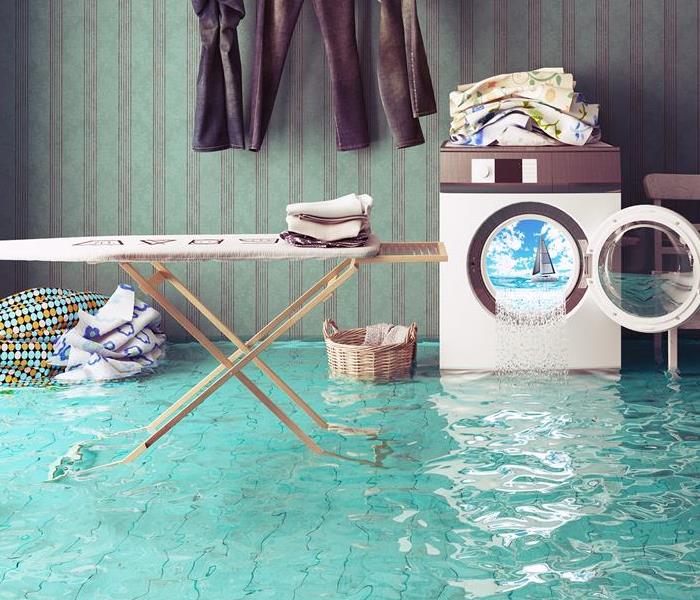
Who doesn't hate the dreaded BF words? We're talking about basement flooding. If you're a homeowner in the city, this term has probably crossed your mind more than a few times. New York basements are susceptible to flooding from rain, burst pipes and even sewage leakage. Unfortunately basements are usually the first areas to flood, whether they're finished or unfinished. That's why you should have SERVPRO of Midtown Manhattan in your contacts list to provide emergency service for basement flood cleanup.
The company knows that your home is an important and cherished investment, that's why it provides 24 hour, full flood damage care in NYC. Expert representatives guide the New York home or business owner through the process. Once the water is extracted from your basement, they are also the clean up and repair crew as well. Experts check the temperature and measurements of your basement to ensure they have the proper equipment to perform the job completely. Technicians then utilize pumps and vacuums to remove gallons of water. Dryers and dehumidifiers are then set up to remove hidden moisture that basements carry. The experts work quickly and efficiently to prevent mold from creeping in.
Once the drying process is complete, SERVPRO cleans and sanitizes the area. Disinfectants or antibacterial and antimicrobial treatments are used for a thorough cleaning. If the flooding caused damage in your NYC basement, the company begins the repair process by fixing drywall, performing minor reconstruction and even carpet replacement.
If you find yourself in a flooding predicament, SERVPRO of Manhattan has resources to handle the smallest or largest commercial or residential basement flooding disaster. The company understands the importance of getting you back into your normal routine in a timely manner with a flood-free basement.
Cleaning Up After A Flood At Your Business
1/23/2019 (Permalink)
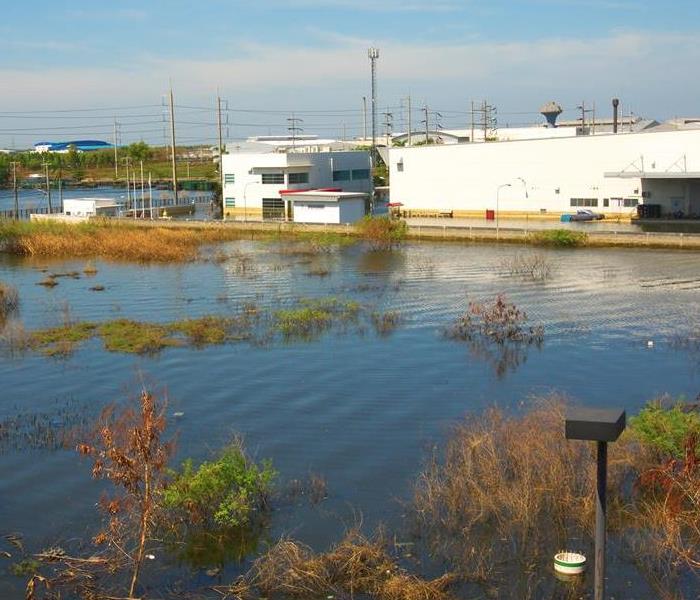
There are many events that can be a physical and financial disaster for your business. One of the biggest events a business owner fears is a fire. In New York businesses that are located at the bottom of a sloping road are at risk of facing flooding risks if NYC is hit by a storm with sudden downpours. When this happens, a company such as SERVPRO can provide services ranging from consulting to clean up related to the flood.
One of the first things a company should do is get all of their equipment and supplies off of the floor. Place it on tables, chairs and counters. If the bottom of the box is wet, remove the items from the box to avoid that moisture seeping into your papers or supplies.
If the water has risen to a level where it reached the electrical outlets at any time during the flooding, do not use those outlets. You will need to have them professional inspected. Using them without inspection can be a high risk for shorts and fires in your office.
The key as a business owner is to do everything you can to minimize the damage your office experiences from a flood. It can be a frightening and surprising situation to encounter, but keeping your wits about you can save a lot of money for your business. Having a professional inspect your office before using the equipment is advisable if you want to reduce the risk of further damage costs.
SERVPRO is a great company to call for flood damage restoration
1/23/2019 (Permalink)
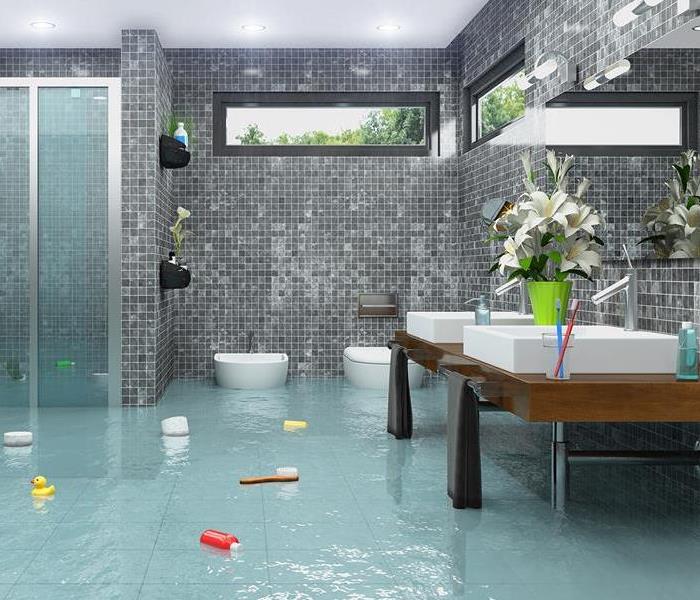
Has a flood overtaken your basement or maybe even the ground level on up of your home? Is the damage to the point of agony and causing grief, making you feel as if you are unsure what to do next? Have no fear, there's only one step you need to take. And that is to call your local SERVPRO, serving NYC and the greater New York area as well (there are also SERVPROs across the nation, so if you are not in this area just take a look around the web for a local business, and we will have you back into normal activity in no time).
Here at SERVPRO, we are the leading water removal and cleanup guys that are always ready to take care of your Manhattan home or business if flooding or water leaks cause damage to your structure, foundation, or anywhere else. We will speedily dry up your property using unique and super-effective water removing equipment and innovative drying procedures, all while documenting the entire process, making sure your property is left like new and the duty has been served right.
A few things consider immediately following flood and water damage:
Should you stay in the house? Is it safe?
Be aware of electrical and slip hazards from the water contact.
Only attempt to take care of things that are safe for you, when in doubt, leave it out.
Also keep in mind that wet materials become VERY heavy, very fast. Be extra cautious.
What you should do after flooding
Mop up and blot excessive water.
Remove excessive water off of wood furniture after you remove lamps and other tabletop items.
Take off and put wet upholstery items and cushions up out of water
Put aluminum foil or wood blocking between furniture legs and soaked carpeting.
Turn your air conditioning or heat on for max drying effects.
Take colored rugs off of soaked carpeting.
Move art objects to a dry and safe area.
Pick up loose items from your floors.
What you do NOT do after flooding
Do not leave wet fabrics in place, hang them to dry, such as furs and leather goods.
Do not leave magazines, books or other dyed or colored objects on wet floors or carpets.
Do not vacuum to remove water or moisture.
Do not use electronic devices or appliances.
Watch for wet, sagging ceilings and do not power your ceiling fan if the ceiling is wet. Jump to top
How to Handle a Sewage Flood
1/23/2019 (Permalink)
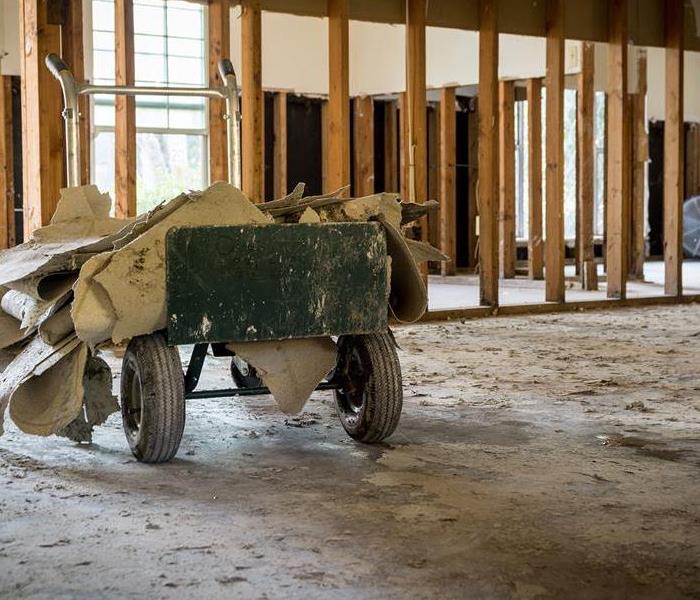
A part of any kind can be devastating. There is the cleanup, the risk of bacteria and mold, and the biggest risk of all is the risk of electrocution due to the water mixing with the electricity. Sewage backup and flooding situation you should not attempt to do the cleanup yourself. There is much more involved than just putting on some rubber gloves and putting things in trash bags, there is a risk of infection an illness due to the amount of bacteria present. Call your gas and electric provider and have them shut off service until proper cleanup can be conducted. Do not attempt to turn off power yourself, as doing so can lead to electrocution. Cleaning up after a sewer backup in flood is more involved than just drying the area and disinfecting. the bacteria present can lead to serious serious illness including but not limited to Hepatitis A, E Coli and tetanus. Depending on how much water is present it can begin to seep into the floor and surrounding walls, leaving an unhealthy environment around the affected area. Failure to do proper clean up can cause mold, which can be a very expensive project to tackle. SERVPRO is an all-encompassing residential and commercial disaster restoration expert.
All furnishings and other items that the sewer backup came in contact with should be disposed of immediately do not try to save furniture or clothing oh, it's not worth the risk of getting sick. You should also dispose of any food or drink that has been exposed in the area. Make children away from the area until proper cleanup and disinfection have been done. Don’t try and handle this yourself, call a professional! We serve NYC and new york.
Ways to prevent a burst pipe
1/23/2019 (Permalink)
Ways to prevent a burst pipe
New York winters can be very cold, and that can present a risk to your pipes. When pipes freeze, they can burst, which can cause a real headache in your NYC home or building. Here are some ways you can help to prevent your pipes from bursting when the temperature gets below freezing.
Insulate them
Pipes can sometimes be in places without great insulation, such as a garage or crawlspace. To help keep your pipes from freezing and bursting, you may need to add insulation to these areas. This can be in the form of actual insulation, or you may be able to use blankets or towels to keep your pipes warm.
Keep the heat on
If your home or building is vacant for a time, do not shut off the heat. Keep it on and at a lower level to help ensure it stays warm enough inside so that your pipes won't freeze.
Let faucets drip
Keeping your faucets open to allow a drip helps to keep water flowing through your pipes, which relieves pressure and helps to prevent them from bursting.
Disconnect hoses
You should undo any hoses you have hooked up outdoors. Hoses can have water left in the hose bib when they are turned off, and this can freeze, then expand and crack the pipe. Disconnecting them prevents this from happening.
If you do experience a burst pipe, the experts at SERVPRO can help with clean up and restoration of your property.
Winter Pipe Bust Protection
1/23/2019 (Permalink)
Winter Pipe Bust Protection
Winter is a cold time that's full of many hassles, and if your pipes burst, you're in a really bad position. When the weather gets cold, if your pipes aren't prepared, you could find yourself with water flooding your house from a burst pipe. But there are things that you can look out for so that you know that your house is ready. And SERVPRO in New York and Manhattan can help you.
Insulation
When you want to make sure that your pipes won't burst when the weather gets cold, one of the most important things that you should look into is your insulation. When you live in colder climates, such as NYC and Manhattan, one of the most important things to think about is the insulation of pipes on exterior walls. And if you have an older home, make sure that you don't have any pipes running through the attic. Newer homes usually have the pipes running through the walls, but building codes have changed over the decades, and if you have pipes running through the attic, then make sure they're insulated.
Going Out of Town
If you're leaving town for the weekend, you might simply turn your heat down. If you live in a condo, townhome, or many other types of properties that share walls with a neighbor, your pipes will be fine even if your furnace goes out. But if you're leaving your New York home for a couple of months, you'll probably turn your furnace off so that you don't have to pay the bill. In this case, you will want to turn your water main off and empty the pipes by turning the faucets until they have no more water in them.
If you're looking for ways to keep your home and plumbing in NYC safer this winter, there are many basic precautions that you can take. And SERVPRO can help.
Tips for Dealing With Water Damage
3/26/2018 (Permalink)
Water damage can be devastating to your home. It can ruin your floors, your walls, and your possessions. However, if you act fast after the initial damage, you can severely mitigate the amount of damage done. Here are a few tips to dealing with the effects of water damage in your home, as listed by Concrobium.
- Immediately turn off, disconnect, and remove any electronics in the area. Electrical items are some of the most vulnerable possessions in terms of water damage, but can possibly be saved if removed quickly. Additionally, if the water rises above the level of your outlets and electronics, having them connected could lead to you or anyone in the area being electrocuted, so remove them as soon as possible.
- Begin pulling carpet. Carpet can be saved if immediately removed and cleaned.
- Remove the water. There are a few methods you can utilize to begin removing the water from your home. The first is to just start getting rid of it manually. Use any buckets, mops, and towels to soak up and dispose of as much water as you can. Pour the water into drains or into your lawn. Another tool you can use is a wet/dry vacuum. If you choose to go this route, remember to be mindful of using electronics around water. Do not plug in a vacuum if it is susceptible to water damage.
- Once the water is removed, you need to dry out the area. Open all your windows, turn on fans, and use a dehumidifier to dry the affected areas. This is also when you should begin removing any damaged drywall from your home.
- Lastly, you will need to begin to dispose of damaged items. This includes drywall, carpet, furniture, and any other damaged possessions. Find out where in your area you can dispose of these things and do so.
Hopefully, these steps have given you a clear idea of how to being to clean your home after experiencing water damage. As always, if you are a resident in or around New York City, feel free to contact us with any questions regarding home restoration after water damage.
Water Damage
2/12/2018 (Permalink)
Water may seem very unlikely to cause damage. Do not be quick to dismiss it just yet. Water in the presence strong winds can be very destructive. It is for this reason that hurricanes and strong rains have claimed lives and destroyed millions worth of property. Water damage can also be as minimalist as broken water pipes that cause molding and rusting. These broken pipes are ranked second from hurricanes in causing water damage.
There are three types of water damage.
Category 1
This is does not cause any threat to human life. It is from is from broken house appliances and pipes which can flood a house or basement.
Category 2
This is also known "gray water". The water is contaminated and contains chemicals, micro-organisms, nutrients and biological contaminants. This water can cause serious health damage and discomfort when consumed.
Category 3
This is also known as "black water". This water is very unsanitary and contains harmful bacteria, fungi and harmful physical components like sharp tools. The source of this water is sewage, seawater, water rising from water bodies due to heavy rains and ground water.
Classes of water damage
The several classes of water damage help in evaluating water control options.
- Class 1- Water damage is minimal and the materials do not absorb a lot of water making repairs easy and less costly
- Class 2- This class has a fast evaporation rate but other materials like cushions and mattresses may be damaged.
- Class 3- water has the fastest rate of evaporation here and the damage caused is greater and difficult to repair. The water may come from overhead sources and may soak the walls and furniture.
- Class 4- This stage requires professional technique and procedures to control. It may damage concrete and hard floors and plaster
Water Damage Restoration Services
1/23/2018 (Permalink)
Our company provides reliable emergency services related to water incidents regardless of the size of the incident experienced. We have the most proficient workforce that is well equipped to respond to any of your related emergencies. We use the most advanced equipment.
We assure you of the most convenient services that will help in the restoration of your damaged Manhattan home back to the previous state. Our capacity to react faster under pressure indeed provides good benefits in extracting the water and drying the affected property. The company uses the best moisture monitoring equipment that efficiently drains the water out of the damaged property.
Our Water Damage Restoration Process Include:
- Emergency Contact
- Damage Assessment and Inspection
- Water extraction
- Drying
- Repair and cleaning
- Restoration
Reasons to Choose our Services
- We offer the quickest response to water damage
Our strategic location in Manhattan enables us to access any residential or business premise that faces water elated emergency situation.
- We provide services to all sizes of water disaster
- We have competent technicians to handle the water damage restoration services
- We specialize in water and other related incidents
Being the cornerstone of our business, we provide our staff with the most extensive training that equips them with the necessary skills to improve their performance. We strictly emphasize the drying process.
- We provide quick water damage cleanup
Our responses to water and other related incidents cannot be challenged in Manhattan; we provide services all through regardless of time.
- Our equipment and techniques are most advanced to meet your needs
Our company uses the most advanced equipment that plays a significant role in detecting any hidden moisture while extracting possible waters at higher speed. The equipment can clean the messed belonging in the most efficient way as desired.
- The cleanup process is closed by deodorizing and sanitizing your home for safety and comfort.
Professional water damage restoration
9/18/2017 (Permalink)
 Water Damage Restoration Services
Water Damage Restoration Services
Water damage varies depending on the water volumes. Water damage is caused by leaks, faulty plumbing, forgotten running taps, burst pipes, and natural disasters. Sometimes the water used in putting out fire causes water damage. Moisture and flooding ruin walls, floors, ceilings, clothing, curtains, carpets, books, electronics, and clothes. The damage can be little only requiring vacuuming or can be extensive and calls for an overhaul of damaged spaces. Once you find out the source of the leak or flooding, turn off the water source and unplug any electrical appliances. One sure way of ensuring your Manhattan home does not lose its glamour is contacting professionals in the event of water damage. Seek prompt help immediately; if it goes beyond the 48-hour window, restoration becomes challenging and costly.
Restoration process
The following procedure is followed when revamping your home or business in Manhattan after an incident
1. Assessment
The professionals in Manhattan will carry out an inspection to determine the extent of damage; this helps plan on what resources to use during restoration. The evaluation helps them to classify the water damage. It is also done to find out the cause of the flooding i.e. whether it's a clean water source or unsanitary water such as sewers
2. Removal of water
Remove any standing water in the premise using vacuums and pumps. Water extraction should be carried out immediately to minimize the spread of damage. It also halts the growth of molds.
3. Drying affected areas
When all the water has been successfully removed, you are required to dry and dehumidify the affected areas. This process ensures that all moisture is expelled. Depending on the extent of water damage it can take few days or weeks.
4. Cleaning
Dry does not mean safe for use. Space should be heavily cleaned and sanitized. Drapes, carpets floors, and walls are cleaned to prevent the growth of bacteria and molds.
5. Restoration
The final process involves replacement of any damaged materials i.e. floors, walls or ceilings
Water Damage Cleanup Services
9/18/2017 (Permalink)
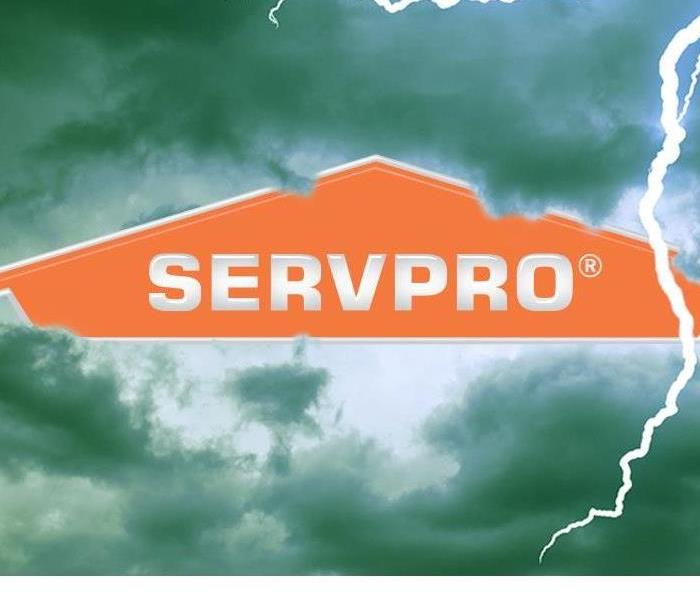 Manhattan Water Damage Clean Up
Manhattan Water Damage Clean Up
Water damage in your Manhattan home or business can happen at any time. From a small leak in your roof to a bathtub or toilet overflow to a broken water heater to major flooding from a storm, water can damage your home or business quickly when you least expect it.
When water damage occurs, there are many factors that you must consider to tackle the issue including how much water you are dealing with, the potential for deterioration, and the rate the materials affected will soak up the water.
If water and moisture are left in items such as furniture, carpet, or building materials such as dry wall or plaster, mold will begin to develop within a day or so. While metals will rust and corrode, drywall will begin to crumble and wood will begin to swell, split, and eventually rot. The main objective is to get the area affected by the water dry as soon as possible.
For minor water damage, you may be able to take care of the issue yourself. An example of a minor issue would be if your kids decide to get water all over the bathroom floor and you immediately mop it up. Since the potential for mold and structural damage is minimal, you can handle it yourself.
When there is major flooding in your home or business and walls, flooring, and even insulation is saturated, it is time to call upon a professional water damage restoration company. The technicians are experienced at water eradication and will be able to dry out the affected areas much quicker, decreasing the chance for dangerous mold to form and the possibility of damage occurring. The technicians are also aware of electrical hazards, health risks, and other safety hazards so they can remove the water in s safe manner. They also have the specialized equipment such as HEPA air scrubbers and dehumidifiers to remove moisture and odor in the air, leaving your home or business fresh, clean, and dry.
How to Recover and Restore Your Manhattan Home
6/30/2017 (Permalink)
Excess water can hurt a home in ways we never thought possible. Staten Island homes are often the victims of flooding and storm damage, which can do much more than cause appliances to rust. Warped floors and walls are only the tip of the iceberg. Without proper water cleanup and removal, homes risk developing smells and growing mold.
If you have been the victim of recent storm damage, there are some ways to minimalize the impact on your home. After you have assessed if the area is safe, try some of these tips:
- Soak up whatever water you can, but don't leave wet towels on the floor. This can cause warping.
- Remove any rugs on the floor, even if they are soaking wet, and hang them up outside. This can minimize the amount of liquid and weight on the floor.
- Remove any hanging art or electronics. Water can start to evaporate, leaving the room feeling murky. You don't want this excess moisture ruining something valuable.
- Place wood blocks underneath furniture to minimize contact with the wet floor if you can't move them out of the room.
- Take advantage of air conditioners and fans; they can help dry floors faster.
- Don't hesitate to contact a restoration specialist. Issues with moisture only get worse over time and the right specialist can help remove the water as quickly as possible.
Never be afraid to contact a specialist. Whether your Manhattan home has a flooded basement or large moisture spots on the ceiling, we can help identify the cause of the damage and help you make changes. Our goal is to help you quickly and easily restore your home. Contact us today to learn more.
Why you need a professional to fix water damage problems at your home
6/9/2017 (Permalink)
Water damage can happen when you least expect it. Sometimes it may be as a result of leakages that you have been ignoring, or it can be an aftermath of a fire or flooding. Therefore, it might find you when you are not prepared financially to hire external help. So the first thing that will come to your mind is how to fix the water damage on your own to save money. You can do a very good job at dealing with water damage in your home in some situations, but if the damage is too severe, you will need the input of well-trained professionals to fix it for you. Here are the reasons why hiring professionals to do the work is the most prudent thing to do;
Once on site, professionals can quickly determine what items have been severely ruined by water damage. They will begin by getting rid of any porous items that could have come into contact with water because they tend to absorb too much water which can act as breeding grounds for harmful microbes. These items include mattresses, particle board, box springs, and pillows.
Professionals will also identify any pockets that are holding excess moisture and remove the water. They have special equipment that they can use to measure moisture in hidden areas such as beneath tiles and other materials that do not become wet easily. When they find the hidden pockets, they will expose them to air by taking out the tile or material above it. They will also clean all areas with moisture using methods such as pressure washing with strong detergents. They will also accelerate the process of drying to prevent mold growth or any harmful bacteria. If the professionals discover the presence of bacteria or mold in your house, they will use mechanical or chemical methods to eradicate it.
At SERVPRO, we have experienced professionals who can spot compromised areas in your house and do everything possible to restore it. They are certified through a recognized organization. We serve New York City and Manhattan areas. Visit our website here http://www.SERVPROmidtownmanhattan.com/ and find out more about us.
How to prevent water damage in your home
5/26/2017 (Permalink)
Water damage is said to be one of the worst problems that homeowners face. There are numerous causes of water damage in a home that can be attributed to the weather or an old plumbing system. These causes include the AC soaking the ceiling, fire sprinkler systems might freeze, cold weather can cause pipes to burst, blocked draining, and garbage disposal might flood cabinets. Pressure getting to the washing machine, running or dripping toilet, leaking water heaters, sump pump fails to pump, and sewer lines backing up can also cause severe water damage in a home.
Clearly, water damage can cause a lot of damage to your property which will cost you a significant amount of money to repair. In some instances, you will be required to replace walls or doors because the extent of the damage could have affected the integrity of the existing ones making it unsafe to live in the home. The best thing to avoid spending a lot of money on repairs is to prevent water damage from happening.
There are three key ways of preventing water damage that every home owner should know and apply.
- Watch out for water leaks and address them; inspect your roof occasionally and repair any damaged, loose and missing shingles. You should also check for stains on ceilings, toilets that shake and dark spots below pipes.
- Ensure all drainages are working perfectly; you can accomplish this by cleaning the gutters and downspouts on a regular basis, and making sure that your yard has sloped some distance away from the foundation.
- Test electrical appliances frequently; check to ensure that water heaters, the sump pump, and washing machine are in good working conditions.
The other steps you can take to prevent water damage is to;
- Keep track of your water bill
- Disconnect hoses
- Install water detection devices
- Close your water main whenever you are going away for an extended period
- Take care of your vegetation and trees. Avoid landscaping too close to the utility pipes
If you have done all the above but are still facing water damage problems, it is time to seek the help of a professional. Visit our site here http://www.SERVPROmidtownmanhattan.com/ and book an appointment with us for quality water damage repair services. We serve New York City and Manhattan area and will be happy to put an end to that problem for you.
Water Damage in Manhattan, NY
5/5/2017 (Permalink)
You should check your household fixtures and irrigation systems every year to ensure there are no leaks.
Leaks Cause a Massive Loss of Water
The average home wastes 10,000 gallons of water each year on leaks. This is enough to wash 270 loads of laundry. Nationwide, household leaks waste 1 trillion gallons a year, or the equivalent water use of 11 million homes. Up to ten percent of homes leak 90 gallons a day.
Where Leaks Occur
Common causes of leaks can be spotted easily.
- Worn toilet flappers
- Dripping faucets
- Leaking valves.
These can be easily corrected, which can save a lot of money on your water bill over time. If you have water damage from leaks in Manhattan, contact SERVPRO or visit us online to book an appointment.
Leak Detection
Review your past water bills to detect a spike in recent months. This sharp increase in winter water usage can point to a problem. As an example, a family of four probably has a serious leak problem if the winter water usage is more than 12,000 gallons per month.
Check the water meter once, wait two hours and check it again when there is no water running. If the meter goes up, you have a leak. You can check for a toilet leak by placing food coloring in the tank. If the color appears in the bowl in 10 minutes before flushing, there is a leak in the toilet.
Faucets and Showerheads
A faucet that leaks one drip per second wastes 3,000 gallons a year, which is enough for 180 showers. Fix leaky faucets by checking washers and gaskets and replacing worn ones.
Toilets
If your toilet leaks, you need to replace a faulty toilet flapper. Over time, this rubber part decays and it is very cheap to replace. Replace the entire rubber flapper to avoid future issues. If you end up replacing the entire toilet, look for a WaterSense labeled model, which could save 13,000 gallons each year. Retrofitting your house with WaterSense toilets can save nearly $2,400 in water and bills over the life of the toilets. If you have water damage from leaks in New York City, contact SERVPRO or visit us online to book an appointment.
Why Water Damage is Not a DIY Project
12/16/2016 (Permalink)
Oftentimes, homeowners don't realize the extent of the water damage in their home. Excess moisture is one thing, but damage from a flood, sewer backup or something else can be devastating to your health and your home in general. It doesn't take long for a situation like this to spiral out of control and leave you struggling to figure out what you are going to do to take care of it. The best thing you can do is turn to the help of a professional. Our team has all of the necessary tools to make sure your home is taken care of and the water damage is cleaned up properly.
- Dirty water from sewage backups is loaded with deadly substances from parasites to chemical residues.
- Bacteria, fungi and viruses thrive in contaminated fluids. They pose all sorts of health risks, such as hepatitis and salmonella.
- It only takes 24 hours for mold to begin growing out of control and invading your space.
- Even a small amount of water left undried could be a source of problems for your home.
Our team has all of the necessary tools and experience to come in and get your water damage taken care of and thoroughly cleaned up to prevent anyone from falling ill or mold setting in.
Preventing Water Damage from the Various Weather Conditions
9/19/2016 (Permalink)
Water covers 70 percent of the planet. It can be found almost anywhere you turn. As such, you need to minimize the amount of water in and around your home to prevent rot, insects, peeling paint and a shortened lifespan of your structure. To prevent water damage, do the following:
- Check for any leaks around the doors and windows, especially at the corners. Peeling or discolored paint or swelling around the frame often mean water is leaking into the structure.
- Replace or repair shingles allowing water to get underneath of the roof sheathing. Leaks often occur around the chimney, attic vent or plumbing vent. Water can run along the rafters, truss or attic floors before making its way through your ceiling.
- Seal holes and cracks in the foundation, joints and external walls.
- Check for sweating pipes or leaking faucets. Look for bulges, wetness or cracks on the hoses connected to your washing machine. Inspect your water heater for potential rust and water leakage.
- Keep any trees trimmed to prevent them from touching the exterior of your home.
If you have any questions or concerns about possible water damage, give our team a call. We will come out and take a look at it for you to see what needs to be done.
Getting control over hidden damages
9/4/2016 (Permalink)
Getting control over hidden damages
Do you know that water leaks can highly affect the sale of your home? What's more, they can be a concern for new home buyers. However, most homeowners are usually unaware of the hidden leaks. With cracked pipes, leaking spigot and broken seals water will easily creep into some places it isn't meant to go. The end results will be more visible damages which include rot, damaged flooring, and blistered paint.
A minor water leak can increase your repair bills. But the good news is that you can easily prevent such situations. Noticing a sagging ceiling above your dining room table is easier. When looking for water damages you have to remember that these damages rarely turn up at the water source.
Some damages to expect
- Mold and mildew growth. With water leaks, you should also expect an unhealthy environment.
- Permanent water damages to carpets, wood, wallpapers, furnishing and paint.
- Contaminated systems – including the ductwork.
- Insulation and drywall which need replacement and removal.
- If there is water trapped somewhere in your house, poor airflow will become a major problem.
But don't worry, our technicians are always ready to check out problems and offer solutions. Avoid drying the water and assuming that nothing happened. The sneaky leaks could come back and cause more damages.
Detecting Water Damage
8/15/2016 (Permalink)
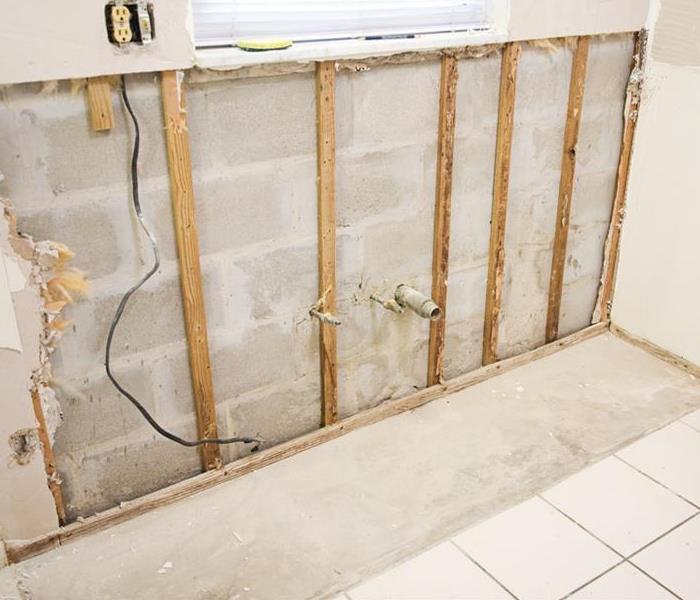 New York City Water Damage
New York City Water Damage
Detecting water damage or leak detection can be a daunting task, but not when you have a perfect strategy like thermal imaging. This marvelous tool often detects the mysterious origin of water leaks at a distance from the physical evidence of water damage while providing visual results that that reveal the actual source of leaks. The common principle that water follows the path with the least resistance or obstacles is used to detect water damage.
If you live within New York City and its environs, SERVPRO is more than ready to serve you in the shortest time possible whenever you have water damage issues. We are an established restoration and cleaning company that is a trusted leader in both residential and commercial services. Here are the main reasons why you should consider New York City's SERVPRO to detect water damage for you;
- We have relevant knowledge and vast experience in the restoration industry
- Committed professionals who will serve you in record time
- We thoroughly document your water damage problems and provide clear communication.
- We utilize modern technology to our advantage by using equipment like thermal cameras, digital cameras, moisture meters and hygrometers
- Excellent physical tools such as measuring tapes
- We deploy proper investigative techniques and do effective research
- 24-hour emergency services
New York City Black Water Damage
7/19/2016 (Permalink)
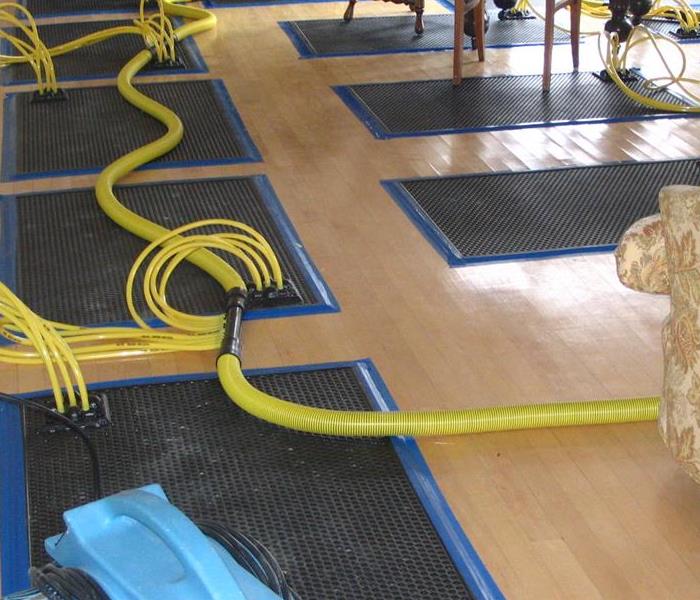 New York City Water Damage Restoration Services
New York City Water Damage Restoration Services
Black water is water that has come into contact with feces. It has harmful bacteria that can cause diseases. The water should not be reused without removing these bacteria first. On the other hand, gray water does not have any human wastes which makes is good for reuse for example in irrigation. White water does not contain any dirt, it is clean water.
Well, depending on the type of water that has flooded your house in New York City or Manhattan; the approach to getting rid of it will differ. The dirty water needs to be removed by SERPRO experts so that they can also decontaminate the place afterward. Even if the clean water is also a bad thing, there is no possibility of a disease outbreak which makes its removal a whole lot easier.
You can recognize the type of water by first identifying the source. Secondly, the source needs to be either closed or redirected to a safer place so that the water can stop getting in, finally is the removal process. Protective clothes are essential when coming into contact with dirty water. At SERVPRO we will take care of the water damage restoration, whether dirty or clean.
Don't forget the Basement!
7/15/2016 (Permalink)
Basement Floods In New York City
Floods are common in basements even for those who live in areas that do not flood causing a lot of water damage. The problem could be from overflowing water containers, water taps that have been left open or water getting in through a crack when there are heavy rains. Prevent any room from a flood in Manhattan and New York City with SERVPRO of Midtown Manhattan experts; we will get rid of the water within no time.
There are several factors that could result in a flooded basement from the outside. These are:
• There could be a small crack on the walls of the basement that allow water to sip in.
• In the event that there are any windows, make sure that you close them tightly when there is a heavy downpour.
• Make sure that water runoff does not pass anywhere near the foundation of the house.
• Ensure gutters are well in place to prevent water from falling near the foundation
The prevention should be from the inside as well:
• Invest in a sump pump to get rid of the water.
• You can also call SERVPRO of Midtown Manhattan experts who will help you remove the water.
• Make sure all taps and water containers are closed to prevent an overflow.
Never underestimate the damage that the water can cause in your house. This makes it crucial to hire SERVPRO of Midtown Manhattan professional water damage restoration services.
Frozen Pipe Season is Upon Us, Here are some Prevention, Preparation, and Protection!
1/19/2016 (Permalink)
Prevention:Locate and identify any and all shut off valves in your property.
Identify any potential problems.
Seal any gaps around the home where cold air may penetrate and become in contact with piping. In the severe cold, especially wind driven, even a tiny opening can let in enough cold air to cause a pipe to freeze. Such as the following:
dryer vents
windows
cable penetrations
Turn off and drain all standard outside hose bibs.
Preparation:
Open sinks and any vanity doors of potential problem areas.
The pipes that are on outside walls are a potential freeze problem, leave a small trickle of the hot and cold water running.
Temporarily seal off any crawl space vents.
Keep the building warm.
If the building will be unoccupied for an extended period of time, make sure the heat is set to a temperature no lower than 55 degrees fahrenheit.
Protection:
If you turn on your water and it trickles out, it is likely that a pipe is frozen.
Keep the faucets open, as the pipe begins to thaw water will begin to flow and this will speed up the melting process within the pipe.
Apply heat to sections of the pipe. You may use the following methods to thaw a pipe:
Do NOT use the following methods to thaw a pipe:
If you are unable to locate the area of the pipe that it is frozen, call SERVPRO of Midtown Manhattan to help you with all of your cleanup and restoration needs!
SERVPRO of Midtown Manhattan, serving your water damage needs anytime, anywhere!
1/11/2016 (Permalink)
 Don’t DIY water damage, call SERVPRO of Midtown Manhattan for all your water damage restoration needs!
212-768-9400
Don’t DIY water damage, call SERVPRO of Midtown Manhattan for all your water damage restoration needs!
212-768-9400
Research shows that every year 250,000 homes are exposed to water damage from bursting pipes. Floodwaters rising only 6 inches in a 30 x 30-foot room can destroy everything in that room. Getting rid of water from a home is only the first phase of the cleanup process. Water also has to be carefully removed from drenched frames, drywall, wall panels, carpets, and anything else at risk for other more complicated mold and mildew problems. Water damage from bursting pipes, no matter how small and seemingly contained, is always a huge water damage restoration project that should only be done with professional help. A small broken pipe in the basement can cause a flood of great proportions. Water does even more damage on the higher levels of a home, where it travels across floors and around frames causing damage to everything in its path until it finally reaches a drain point somewhere.
Bursting pipes can result from malfunctioning dishwashers, leaky washing machines and ice-makers, clogged toilets and sinks, faulty appliance hoses, leaky pipe fittings, frozen pipes and gutters, leaking roofs and ice dams, gaping windowsills, foundation cracks and unsealed wooden decks.
The most treacherous water damage from bursting pipes takes places when water seeps into wool carpet fibers, paper, wood, bits of flaked-off skin, pet hair and dirt most commonly found in well-vacuumed carpeting. It is then that water damage becomes a breeder for various types of toxic molds and decomposition. Depending on temperature and environment, molds will develop within a couple of days. Decomposition usually takes a bit longer, but it will develop. The sturdiest of floors can rot right through from the smallest leaks in refrigerators!
For water damage restoration in New York, don’t take it all upon yourself to make water damage cleanup in your home a do-it-yourself! SERVPRO of Midtown Manhattan offers water damage restoration in Manhattan, Brooklyn, Bronx, Queens, Staten Island, Eastchester, Westchester, White Plains, Bronxville, Scarsdale and all surrounding areas serving New York for over 25 years.
We handle water damage restoration from the largest items in your home right down to the smallest because no project is too big or too small. Our trained Certified Technician Professionals are well-equipped with state-of -the-art cleaning products and equipment making your worst nightmare of a water damage restoration seem like a breeze! We will also put our best efforts forward in restoring time-sensitive documents and refurbishing irreplaceable items that might have been damaged in your flood. Money should not be a time-consuming object as we will work directly with your insurance company.
Prevent Frozen Pipes and Water Damage
12/28/2015 (Permalink)
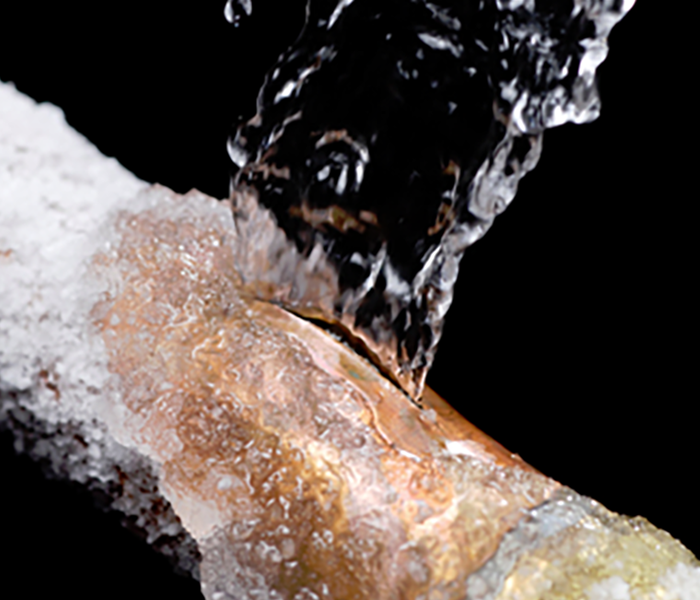 SERVPRO of Midtown Manhattan is Faster to Any Frozen Pipe Disaster, our speedy response will have you bursting with joy!
SERVPRO of Midtown Manhattan is Faster to Any Frozen Pipe Disaster, our speedy response will have you bursting with joy!
Water expands when frozen, this results in tremendous pressure being put on your plumbing which can result in a pipe bursting and lead to a flood and water damage. Below are a few simple tips you can follow to prevent this from happening to you.
Prevent Frozen Pipes
Remove, drain and store outdoor hoses, and close all valves leading to outside water sources.Search for water supply lines in unheated areas, ensure that they are closed.If you cannot close pipes in unheated locations, consider switching to insulated pipes or placing a sleeve over them. Open Kitchen and Bathroom cabinet doors to allow warm air to circulate to the plumbing.In extremely cold situations let the water drip (run very slowly), running water will help prevent your pipes from Freezing. Thaw Frozen Pipes
Do not turn the water on full force right away, let a trickle come out for a short period of time. Keep the faucet open when treating frozen pipes. Apply heat to the frozen sections using a heating pad, hair drier or any other safe heat source. Check all pipes to ensure all are clear and not frozen.In the event of a pipe burst or any water damage the most important thing to do is shut off the water immediately and then contact SERVPRO of Midtown Manhattan to remove the water and affected contents.
How to Save Countless Dollars
Often in the event of water damage individuals tend to wait too long to respond, or simply call the wrong people to respond. When you call SERVPRO of Midtown Manhattan to respond we act swiftly to contain and remedy the situation. This not only prevents future damage but also saves you money.
The Process
- A SERVPRO of Midtown Manhattan Project Manager will be dispatched to your location to turn off the water source if possible and evaluate the situation.
- One of our local response teams will be dispatched to the water damage.
- The water will be contained and completely removed.
- The affected contents will be contained, removed and restored if possible.
- We will then bring in our advanced air moving and dehumidification equipment. Our experts will set up the air movers and dehumidification equipment for an efficient and complete drying.
- We will continuously return to the site to ensure that the affected area is properly drying, and to ensure that all the moisture has been removed.
- A Post-Job evaluation will be made to confirm all the moisture and affected contents have been removed and the situation has been remedied.
3 Reasons to Hire SERVPRO of Midtown Manhattan for Water Damage Cleanup
12/21/2015 (Permalink)
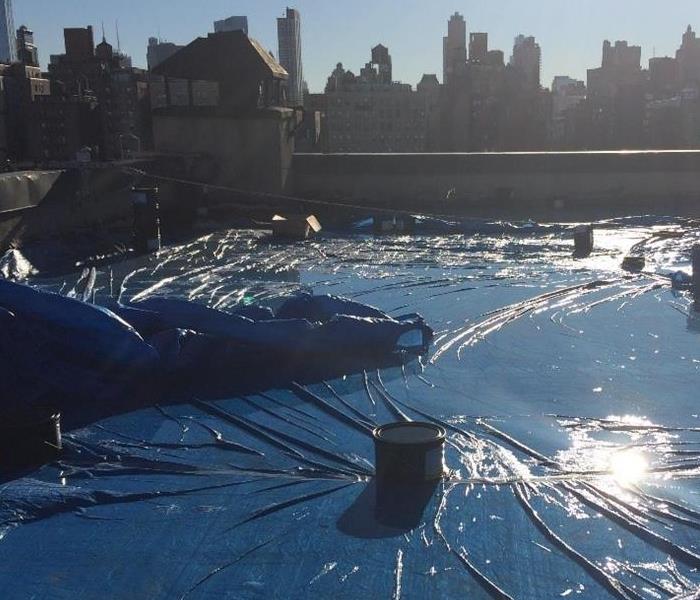 Anything can lead to water damage, this is an example of the improper covering of roof construction during a light rain. This water damage flooded the
Anything can lead to water damage, this is an example of the improper covering of roof construction during a light rain. This water damage flooded the
1. Our Experienced Team
SERVPRO of Midtown Manhattan only employs the most qualified people for our water damage cleanup services. Our team has had years of professional experience in the field and we know how to get the job done. Our expertise has developed through lots of hands on experience and on-site training. Since water damage cleanup is so important and time is of the essence, our teams are taught to move at an efficient pace. We recognize that water damage can harm your property but also the physical and emotional health of your family. With this in mind, we set to work with your best interests in mind.
2. Our High Quality Cleaning Technology
We take pride in the water damage cleanup services we offer. We use high quality cleaning technology and professional grade cleaning materials. We have invested in high tech water removal and drying equipment that does the job quickly. We also use new deodorization and sanitization procedures that allow us to complete large jobs with the same great quality and speed of work. Our technology and cleaning products combine to get your property dried and cleaned efficiently. We also work to prevent any mold or bacteria from growing once the water damage cleanup is complete.
3. Our Affordable Services
Even though we produce excellent results, we believe that water damage cleanup should be an expense that is affordable for homeowners who need it. We understand that water damage happens and that our services are often necessary to restore your property. We have set our service rates to be very affordable, while not compromising the quality of our service. We provide quotes upfront without any hidden charges. You will know exactly what our project will cost you – right from the beginning.
If your home or property is in need of immediate water damage cleanup, visit www.SERVPROmidtownmanhattan.com for more information or call us to schedule a consultation. We can assess the damage, provide you with a quote, and get started right away.
 Water knows no boundaries - even in the heart of NYC. Don't let unexpected floods dampen your spirits, let SERVPRO Manhattan restore your home and pea
Water knows no boundaries - even in the heart of NYC. Don't let unexpected floods dampen your spirits, let SERVPRO Manhattan restore your home and pea





 24/7 Emergency Service
24/7 Emergency Service

